
- 309-550-7543


Judy Gordon
- October 15, 2020
- Motorcycle Rides
- Motorcycle Rides , Motorcycle Trip , Motorcycle Trip Planner
Cross Country Motorcycle Trips | Routes, Tips, Rides for Cycling Cross Country
Last Updated on: 14th April 2023, 03:44 pm
If you own a motorcycle, it is basically a right of passage to do a cross country motorcycle trip at some point. There is nothing like the wind running across your body as you venture out onto the open road. All you need is your motorcycle, the right gear, and a road trip plan to make it a trip worth remembering.
In the United States, there are a huge number of routes you can take for your motorcycle trip cross country . You can explore the deserts of the Southwest or bar hop your way along the East Coast’s most populous cities. Whether you want to camp on the beach in California each night or discover America’s greatest national parks, there are plenty of places you can visit.
Some of the world’s most amazing landscapes are only a few hours or days away from your home. With a bit of planning, you can prepare for the motorcycle road trip of your dreams.
Table of Contents
Planning Your Cross Country Motorcycle Trip
If you want to go on the best cross country motorcycle trip, you’ll need to be prepared and make a detailed action plan . Along with picking out cross country motorcycle routes, you also need to get your bike ready for the road. As the old saying goes, an ounce of prevention is worth a pound of cure.
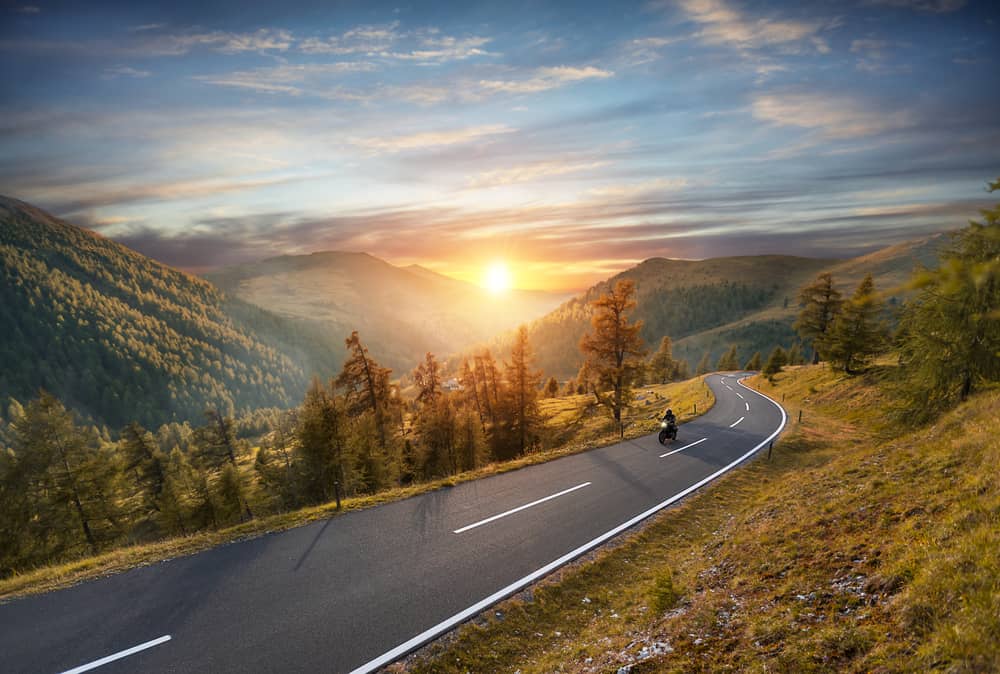
Before you go, check your tires to see how much tread they have left and get an oil change. You should also pack your own maintenance tools like a tire-repair kit. Unless you are a talented mechanic, you should bring your bike to a shop to be thoroughly serviced before you leave on any trip covering a larger distance.
Because even the best preventive measures won’t stop every disaster from happening, you should also get insurance with roadside assistance or invest in AAA. Make sure you also have a reliable phone service provider to ensure you can reach out to someone for help in case of an emergency.
Depending on how long your motorcycle cross country journey is, you may want to get a luggage rack added to your bike so you can bring along some extra necessities. Most luggage racks can be purchased for around $100. Then, you can easily and conveniently store extra gear and equipment.
There is bound to be some bad weather at some point along the road, so you should be prepared for anything. You should have a weatherproof riding suit before you go cross country by motorcycle. While you may never have to wear it, you will be glad you packed it if the weather turns bad.
Along with weatherproof options, you also need to pack boots, clothes, a first aid kit, cash, and a tire patch kit. While leather motorcycle suits are popular because of their durability, comfort, and strength, you can pack whatever suit you feel most comfortable in.
Since you are going on an adventure, you should also invest in a GPS navigation system . If you use a smartphone, it most likely already has GPS navigation options available.
Along with packing the right gear for your cross country motorcycle trip, you can also protect yourself through additional safety measures. Riding with a friend gives you support if something goes wrong as well as companionship. If you are riding alone, calling home regularly and giving someone a copy of your route are both great ways to stay safe.
Top Motorcycles for Cross Country Trips
When it comes to a cross country motorcycle trip, which bikes are the best? Should you get a Harley Davidson or a Honda? Much of your decision will depend on the type of motorcycle you want.
Some people prefer Harley Davidson because of its classic appeal and reputation for a smooth ride. The Harley Davidson Electra is an excellent choice as a touring bike because of its mellow ride, GPS, and reliability.
If you want an impressive bike, the BMW R1200GS is bound to please. This bike is fast, agile, and known as one of the best cross country motorcycles ever. It offers smooth handling, heated seats, and protection from wind and weather.

For a sporty option, check out the Suzuki V-Strom 1050 ABS . This bike has 1,037 CC and two-stage traction controls. While it has low ground clearance, you’ll sit high in the saddle because of the upright seating position.
With the Kawasaki Vulcan 1700 Voyager ABS , you can enjoy having a superbike for long journeys. You’ll love the comfortable cross country motorcycle ride thanks to the bike’s cruise control, intercom/headset system, and integrated saddlebags.
A Ducati Multistrada 1260 S Grand Tour is perfect if you want a modern take on a classic bike. It boasts 1,262 CC, a small size, and versatile gadgets. Recognized as the Swiss-army knife of touring bikes, this motorcycle is great for commuting and long touring trips.
Another great option if you are traveling cross country by motorcycle is the Yamaha FJR1300 . This bike has 1,298 CC and cruise control. It is popular for touring thanks to its heated seats, comfortable ride, and luggage mounts.
You could also go with up-and-coming motorcycle brands that are developing great bikes at affordable prices. These include companies such as Janus Motorcycles , Royal Enfield , and others.
5 Best Cross Country Motorcycle Routes
If you are planning a cross country motorcycle trip, there are a number of routes you can take. You will want to base your choice according to where you are currently located as well as how long you want your trip to be. If you are uncertain about which cross country motorcycle routes are best for you, you can always mix several different routes together to make your dream journey.
1. Pacific Coast Highway
The Pacific Coast Highway is a popular choice for a motorcycle trip cross country. You begin at the northwest point of the Olympic National Park in Washington state. Then, you follow the Pacific Coast Highway for 1,650 miles until you reach San Diego, which is also well known for its many great motorcycle rides .
This journey follows a two-lane road. Throughout the journey, you can enjoy seeing temperate deserts, the Three Capes Loop, the Olympic National Park, and Redwood National Park. Cities you’ll pass through include Seattle, Portland, Sacramento, and Los Angeles.
2. The Great River Road
This is one of the best cross country motorcycle routes within the interior of the United States. It follows the GRR from the Mississippi River’s headwaters in Minnesota to the ocean in Louisiana. Throughout the journey, you can check out sites like St. Louis, Main Street USA, New Orleans , and the Natchez Trace Parkway.
You can stop and see the Mall of America in Minneapolis, the Gateway Arch in St. Louis, Graceland in Memphis, and Bourbon Street in New Orleans.
3. The Atlantic Coast
This is arguably the best cross country motorcycle ride on the East Coast. You begin in New York and drive 2,000 miles south to Key West. Most of these miles are within earshot or visual sight of the Atlantic Ocean , making it a beautiful and scenic trip.
As you drive along the Overseas Highway, you can enjoy seeing sites like the Statue of Liberty and the Assateague Island National Seashore. Along with checking out Key West, you can also stop at Cocoa Beach and Savannah.
4. The Border to Border Road Trip
With this road trip, you can drive from Jasper National Park in Canada to the Sonoran Desert in Arizona. If you love rugged landscapes , this is the cross country motorcycle trip for you. You will see glaciated valleys, tumultuous rivers, deserts, and majestic mountains.
Plus, you can stop to check out the Columbia Icefield in Alberta, Canada. Along the way, make time to explore the Joshua Forest Parkway, Nevada’s Extraterrestrial Highway, and Montana’s Bitterroot Mountains.
5. The Historic Route 66 Road Trip
This iconic motorcycle journey goes from Chicago to Los Angeles. By driving historic Route 66 , you can check out many styles and cultures of America. Some of the most popular destinations along this route are Tucumcan, Santa Monica, the Painted Desert, the Meramec Caverns, and Chicago.
Riders will enjoy everything from classic diners and bars to scenic rides through everything from deserts to national forests.
Plan Your Cross Country Trip
Are you ready to go on your cross country motorcycle trip? With a little planning, you can head off on any of these journeys and enjoy the ride. Once you have completed your first cross country trip, you can always try out a new route on your next vacation.
Need help transporting your motorcycle? Whether you’re planning to take it on a cross country motorcycle trip or are moving to a new area, Federal Motorcycle Transport can help! Give us a call today at (309) 550-7543 to get a free estimate!
Search by Category
Search For more helpful Resources
Check Out Our Related posts

Top Michigan Motorcycle Events – Swap Meets, Bike Blessings & Motorcycle Rallies in Michigan
Last Updated on: 16th April 2024, 10:42 pm Michigan, known for its stunning landscapes and open roads, is a haven for motorcycle enthusiasts. Each year,

Best Motorcycle Rides in Massachusetts 🌉 | 7 Top MA Motorcycle Roads
Last Updated on: 8th April 2024, 01:44 pm Rev your engines for the Bay State! Nearly 150,000 Massachusetts residents are registered motorcyclists. You can explore

New Mexico Motorcycle Shipping – Federal Motorcycle Transport – NM Motorcycle Transport
Last Updated on: 7th April 2024, 03:27 pm With its desert terrain, rugged mountain ranges, and winding scenic roads, New Mexico is a wonderful state

Florida Motorcycle Laws | 🏍️ Florida Helmet Law, Motorcycle Endorsement, and More
Last Updated on: 29th March 2024, 09:10 am Are you thinking of hitting the open road on your motorcycle in the Sunshine State? Before you
Our Clients' Feedback
Our reviews, federal motorcycle transport.
4.91 stars based on 313 reviews

Member Discounts

200 National St East Peoria, IL 61611
309-550-7543 Monday thru Friday 8:00am to 5:00pm CST Email: [email protected]
We are an agent for

© 2023 Federal Motorcycle Transport | Privacy Policy | Shipping Terms and Conditions
Riding cross-country on a motorcycle is miserable—and the most amazing thing ever
Four friends battle breakdowns and thunderstorms while riding some of the most beautiful roads in North America
By Roadtrippers
There’s a scene right at the beginning of the 1969 movie “Easy Rider” where Peter Fonda glances at his watch, then tosses it to the ground. A moment later, he and Dennis Hopper kick their chopper motorcycles into gear and ride off into the desert, as Steppenwolf’s “Born to Be Wild” starts playing over the intro credits.
It’s a cliché, of course, but for bikers everywhere it also speaks to a deeper desire; the refusal to abide by society’s concept of time, and the quest for the kind of freedom you only find in the saddle of a Harley-Davidson. All while riding cross-country with a gas tank full of drug money and not a care in the world.
Remove the drug money, and you have a pretty good idea of my ideal vacation.
As a kid growing up in Sweden—far from deserts, red rocks, and quirky roadside attractions—I spent most of my life romanticizing the great American road trip. I’ve lived in the U.S. for over a decade now. Still, the idea that many of the world’s most spectacular landscapes lay so easily within reach—just a few days of driving away—taunted me.
Life got in the way, though, as it often does. And it wasn’t until earlier this year that I was able to finally take the cross-country motorcycle road trip I’d been dreaming of, in the saddle of my trusty, all-black 2015 Harley-Davidson Dyna.
In late June, after months of careful planning, we finally headed out. The caravan consisted of my boyfriend Paul, my best friend Katie, Katie’s husband Jordan, and me. The plan was to start in San Diego, California and work our way northeast, up to Banff National Park in Canada, while avoiding most major cities and highways. Admittedly, Banff was a somewhat arbitrary destination. In fact, we decided on it after I saw it on TV and instantly fell in love.
It was an atypical American motorcycle road trip in some aspects. We didn’t go coast to coast. We barely touched Route 66 . And despite going from Southern California to Canada, we’d be staying far away from the coast and Highway 1.
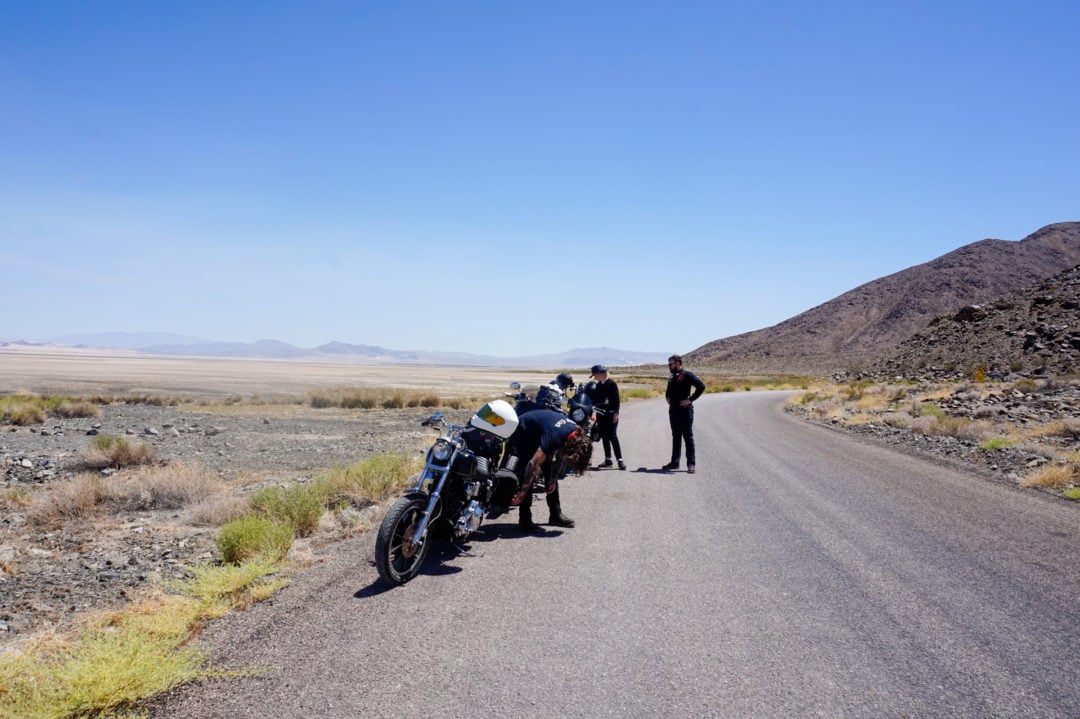
Riding motorcycles can be miserable
On our first day, we made our way from San Diego to Las Vegas, Nevada on Interstate 15. That stretch of freeway is arguably one of the worst in the west: Nothing but heavy traffic, bleak desert towns, and massive, fast-fading billboards framed by a cloudless sky. Somehow, these images underscore the relentless heat of the place.
Rolling into Nevada in late June feels almost biblical: The closer you get to Sin City, the more hellishly hot it gets, as if you’re riding into the Book of Revelation. Forget uncomfortable. On a motorcycle, wearing a full-face helmet and protective gear, 108 degrees of dry, unrelenting desert heat can be seriously dangerous. Accordingly, we decided to blaze through the hottest parts of the trip—Nevada, Arizona, and southern Utah—as quickly as possible.
Riding cross-country on a motorcycle sounds romantic—the wind in your hair, the open road, that very specific American brand of freedom captured so perfectly in “Easy Rider.” But in reality, it can be a pretty miserable experience.
You feel every change in temperature, every bump in the road, every wind gust, every straying bug swarm, every mile seated in the same position—and you feel it across your entire body. After a few hundred miles in the saddle, your body discovers new ways of being sore that you didn’t know were possible. On a cross-country trip, you’ll inevitably wish for warmer gear in the cold, and cooler gear in the heat.
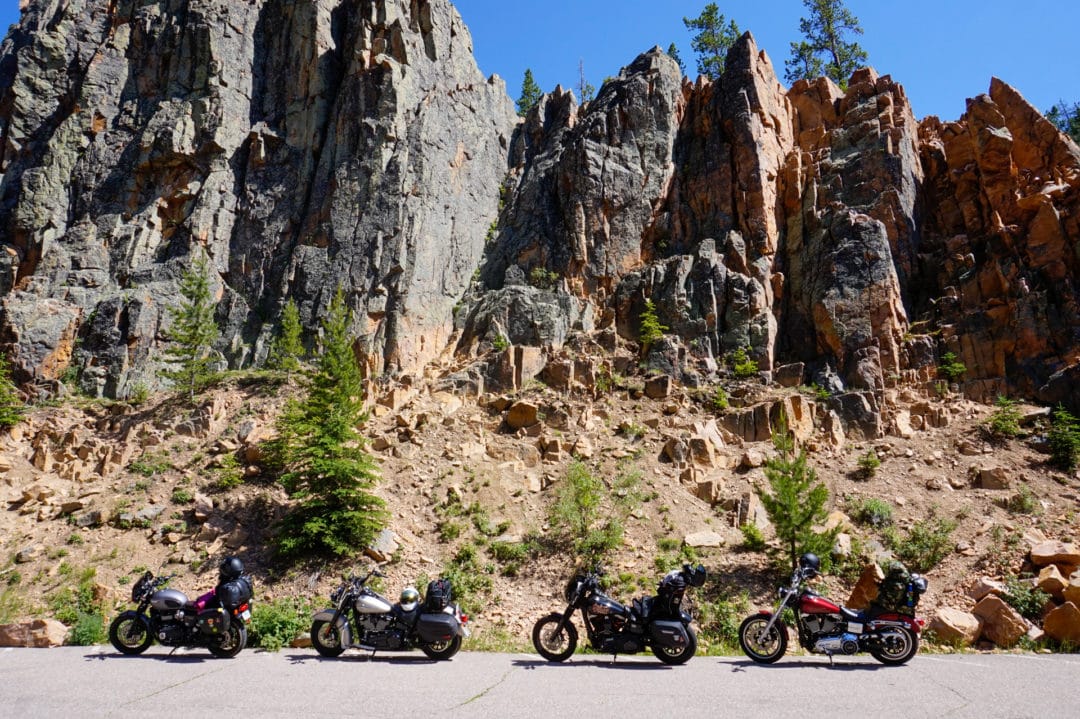
You might run out of gas or get a flat tire—no big deal in a car. On a motorcycle, though, either one can easily turn into a life-or-death situation. And yet, at any given moment, there’s nothing I’d rather be doing than picking a destination, turning up the music in my helmet speakers, and hitting the road.
And I wasn’t alone. We all had our reasons for going on this trip.
Paul was the chopper guy in our group. If it were up to him, he’d be making this journey “Easy Rider”-style: On a 1950s chopper he’d built with his own two hands. It wasn’t up to him, though. The rest of us were on newer bikes and had no desire to accommodate the type of riding you inevitably end up doing on a 70-year-old motorcycle: Slow, unpredictable, and with way too many gas stops.
Instead, Paul ended up riding his newest bike, a 1998 Harley-Davidson Dyna that we had dubbed “The Gentleman.” I bought him The Gentleman a few years ago just so he would be able to go on longer trips with me. I’d be damned if he didn’t ride it on this one.
Katie was my constant road trip companion. When we weren’t actively riding places, we were plotting our next trip. She’s a fast rider, and despite being on a 2017 Triumph Bonneville, the smallest bike in our group, the rest of us constantly had trouble keeping up.
Jordan, Katie’s husband, had survived brain cancer and a serious motorcycle accident—caused by having a seizure while riding, which is how the brain tumor was discovered—in the past few years. This would be his first longer trip since being declared cancer-free, and the first one on his brand new 2017 Dyna.
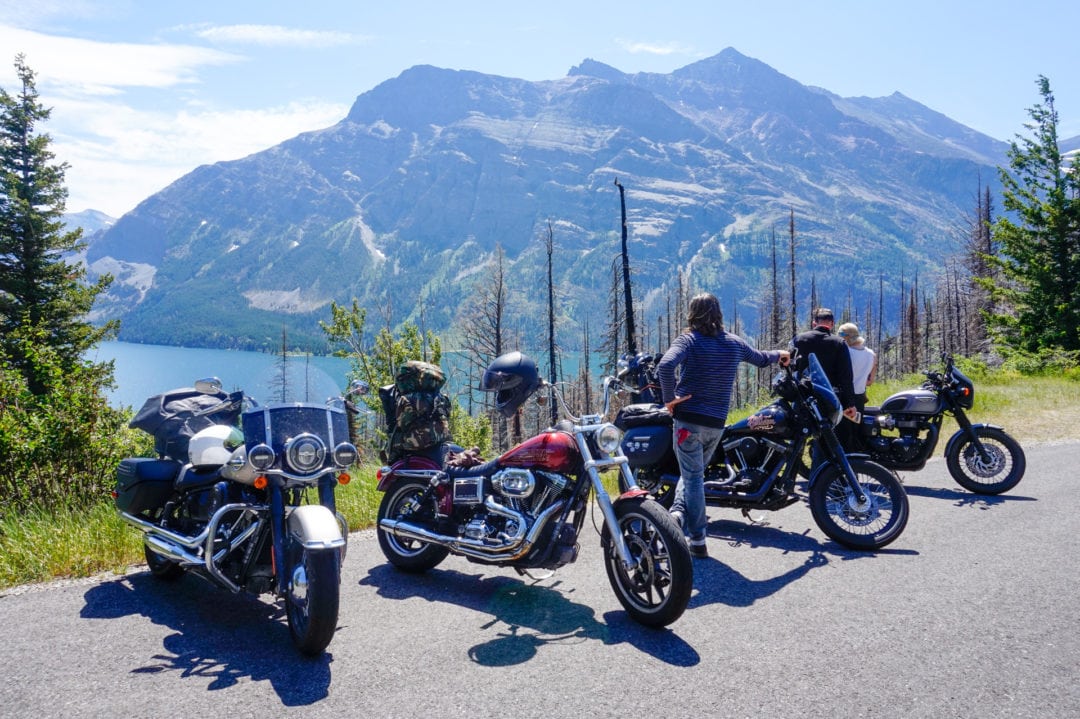
When things don’t go as planned
We made it all the way to Beaver, Utah before our careful planning fell by the wayside. Earlier in the day, we had stopped at a roadside diner serving American “specialties,” like a “bacon cheeseburger salad” that sounded less than appealing. Shortly after getting back on the freeway, Paul’s bike started blowing dark smoke through the exhaust pipe and making very suspect noises. Finally, it just gave up completely.
In hindsight it shouldn’t have come as a shock to us. After all, despite being the newest vehicle he owned, Paul’s Harley was 20 years older than the rest of the bikes in the pack. It had only five gears compared to the six the rest of us were packing. And to top it all off, we’d spent the last 600 miles—perhaps unwisely—breaking every posted speed limit in order to get through the heat. Truly, we couldn’t fault the old bike for not being able to keep up. Now, though, we needed to turn to Plan B … and we didn’t have a Plan B.
Towing the bike to a mechanic shop was out of the question—there was none around. We could borrow a bike, but we had no friends or friends-of-friends in the area. Plus, who’s going to lend their bike for a last-minute 3,000-mile journey? We also momentarily pondered buying a new bike, but deemed that prohibitively expensive.
Ultimately, after a day and a half of trying to fix the bike in a hotel parking lot, the four of us ended up splitting the cost of a rental bike for Paul in Salt Lake City, Utah. It put a serious dent in our travel budget, but none of us wanted to see Paul go home early.
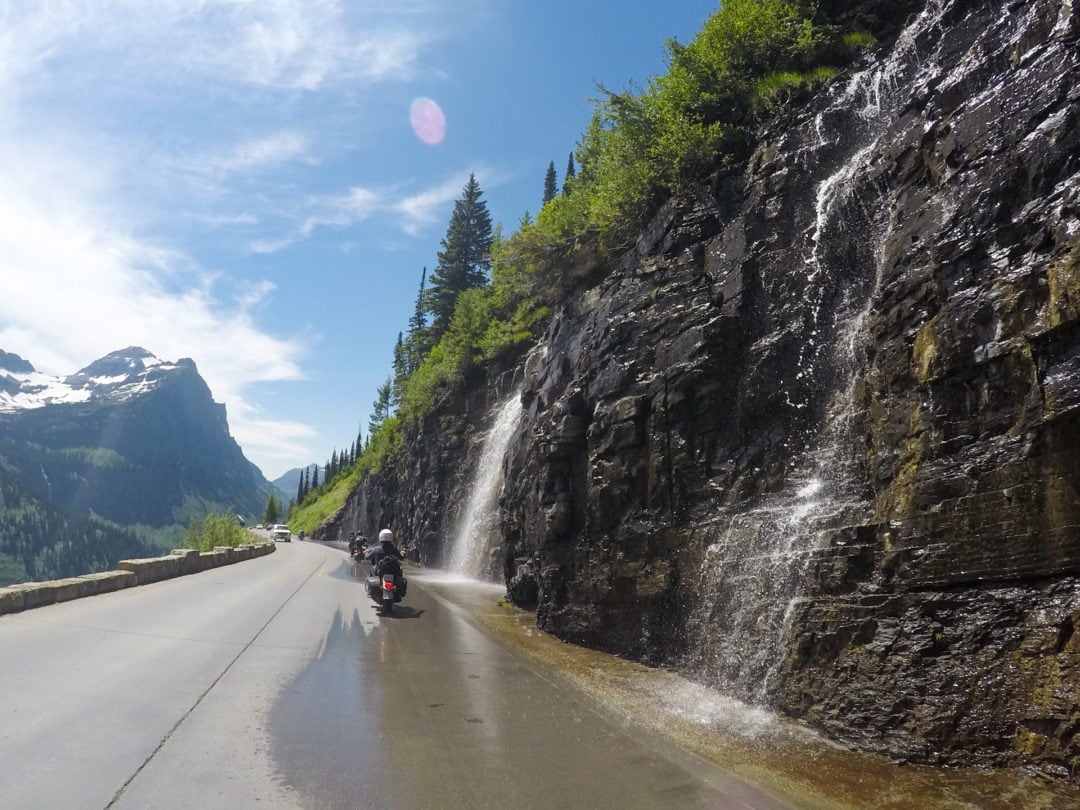
The beauty of Wyoming
At this point, we were running a day-and-a-half behind schedule, and we knew we had some catching up to do. We had a non-refundable hotel room reservation in Canada, and only a few days to get there.
Shortly after crossing into Wyoming, we pulled into a gas station to wipe dead bugs off our helmets and add an additional layer of clothing. It was a strange feeling being cold again after four days of fighting heat exhaustion in the desert.
“Be very careful; these roads are full of deer,” an older gentleman on a BMW motorcycle warned us.
Normally, I avoid riding through wildlife areas in the dark. Hitting a deer on a motorcycle could easily be a death sentence—for you and the deer. But as the old biker saying goes, “Loud pipes save lives.” I suspect the combined noise and vibration from our four motorcycles spooked wildlife back into the wilderness miles before we got close to them.
IT NEVER CEASES TO SURPRISE ME HOW THIS COUNTRY CAN BE SO HUGE AND SO TINY AT THE SAME TIME.
And that’s a good thing, since we found ourselves getting increasingly distracted by the Snake River, which runs through a deep canyon alongside Wyoming Highway 89 just south of Jackson. As the sun was setting behind us and the sky gradually turned vermilion in our rearview mirrors, the river roaring below the cliffside to our right was reflecting the sky back to us for miles and miles.
Surrounded by mountain and forest on one side, and the sunset-tinted river on the other, the four of us rode in collective awe until the sun finally disappeared completely—and with it, any real or imagined sense of warmth.
A few freezing miles later, we rolled into Jackson and stopped at a grocery store. Randomly, Paul ran into an old friend—at 11 p.m. on a Tuesday, 1,000 miles from home. It never ceases to surprise me how this country can be so huge and so tiny at the same time.
An overwhelming sense of presence
One of my favorite parts of any ride with friends is stopping for the night and finally getting a chance to compare notes from the day.
Roadtripping on a motorcycle is by default a pretty solitary activity. In some ways it’s easier than the car equivalent; there are no awkward moments of silence, no fights over music selection, and each person is allowed the privacy of their own helmet for hours at a time. But you also miss out on experiencing things together, commenting on sights and events as they pass by in real time.
View this post on Instagram A post shared by Sanna (@cylinderella)
The hotel we ended up at on the evening of the Fourth of July was perched on the edge of the Yellowstone River in Gardiner, Montana, with a big porch that gave us front row seats to a Montana-style fireworks show. We were right outside of Yellowstone National Park, as evidenced by the town’s backdrop of green rolling hills.
That night, as we’d done every night, we ran through our stand-out memories from the day. We joked about the giant antlerless deer we saw on the side of the road that turned out to not be a deer at all, but a female moose. We remembered in horror the sign at the edge of Yellowstone that read “Motorcycles, use extreme caution.” A moment later, the pavement disappeared beneath us, and was replaced by gravel, dirt, and potholes.
We also reminisced about the many lakes, mountains, hot springs, waterfalls, and wild animals we rode past that day, including a pack of bison out for a stroll down the middle of the road, a mere few feet from our bikes.
Robert M. Pirsig wrote in Zen and the Art of Motorcycle Maintenance : “In a car you’re always in a compartment, and because you’re used to it you don’t realize that through that car window everything you see is just more TV. You’re a passive observer and it is all moving by you boringly in a frame. On a cycle the frame is gone. You’re completely in contact with it all. You’re in the scene, not just watching it anymore, and the sense of presence is overwhelming.”
Being so close to a group of 1,400-pound wild animals that we could have reached our hands out and touched them was definitely proof in support of Pirsig’s point.
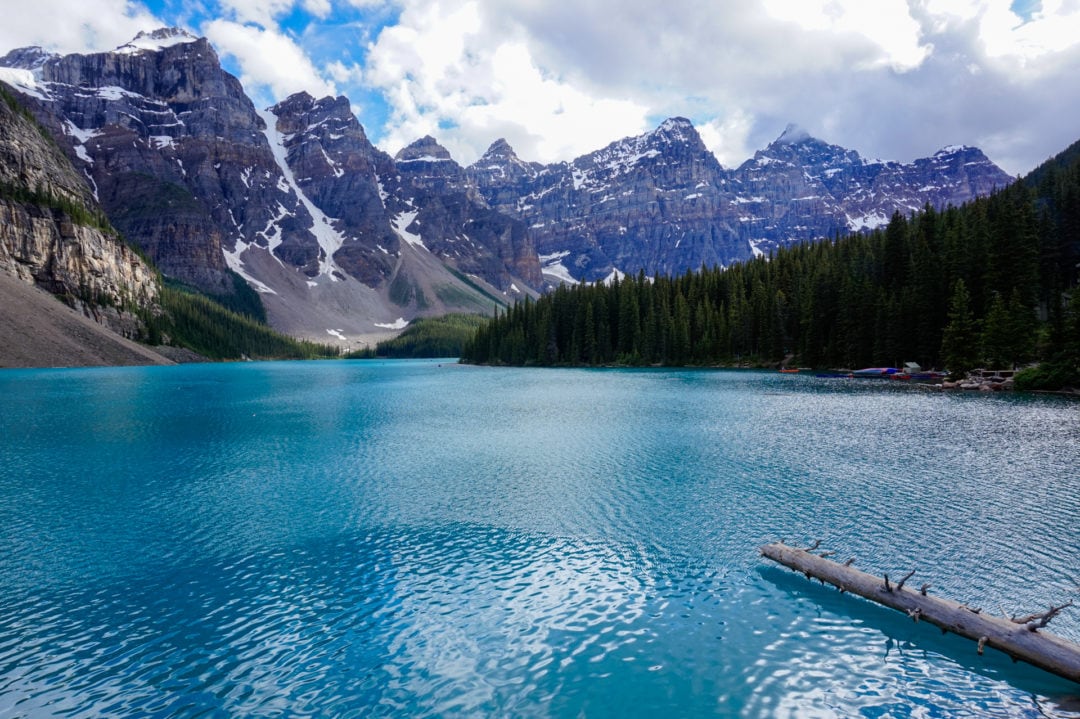
Making it to Canada
When we finally crossed into Canada, the Canadian border officer pointed to an embroidered patch on my vest that read, “More Trees, Less Assholes.”
“I have a t-shirt that says the same thing,” she exclaimed cheerfully. I instantly knew I was going to like Canada.
Even though we were only halfway through, making it to Canada felt like an accomplishment in itself. We had made our way across the entire continental U.S. We snaked through deserts and red rocks in Nevada and Utah, mountains and national parks in Wyoming, and farmlands and small towns in Montana. Finally, we had crossed international borders to arrive in Canmore, Alberta, only a few miles outside of Banff National Park.
During our very first gas stop on the first day of the trip, still in Southern California, we had crossed paths with a fellow motorcyclist who was on his way back to Los Angeles after completing almost exactly the same trip we were on. Back then, a week and a lifetime ago, making it to Canada without any major issues had felt mildly unrealistic.
Now, we were here, surrounded by snow-tipped mountains and bright turquoise lakes. Our bodies ached—four hundred miles per day on a loud, vibrating, non-ergonomic go-fast machine will do that to you. However, we were already getting sad about having to head back home.
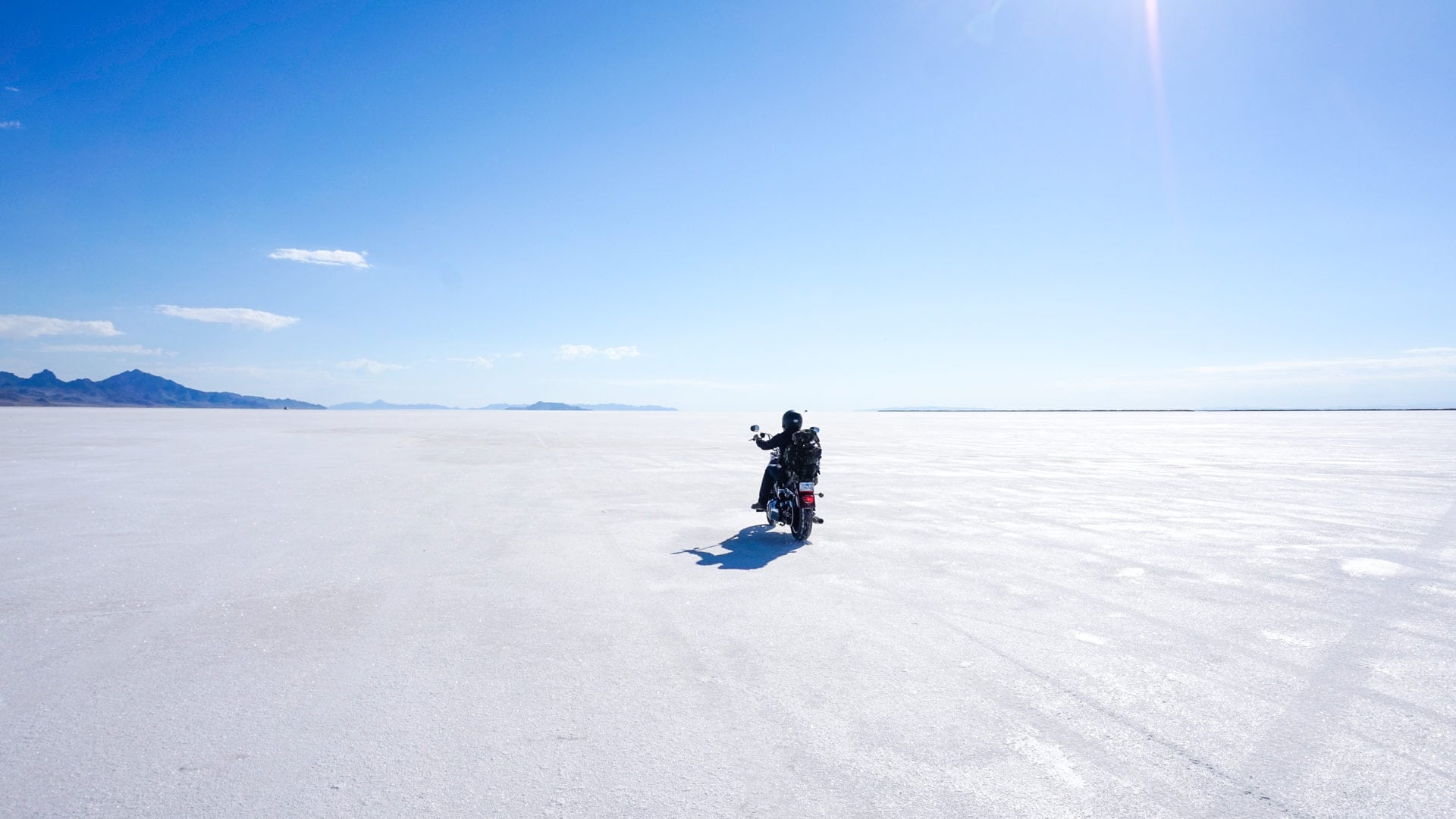
Bonneville is an otherworldly experience
On the second-to-last day of our trip, we woke up on the Nevada side of Wendover, a sleepy resort town that straddles a northern part of the Utah-Nevada border. We had originally booked a room on the Utah side of town, but as soon as we arrived, we realized our mistake. The Nevada side resembled a miniature Las Vegas, with neon signs advertising casinos and liquor stores.
The Utah side, however, seemed largely abandoned. We saw virtually no people, and the whole place had an eerie, almost post-apocalyptic vibe about it. We quickly canceled our reservation and headed across the state line, straight to the nearest casino.
The reason we had ended up in Wendover—a 120-mile detour from our homebound route—was its proximity to the Bonneville Salt Flats. As the venue of numerous land speed records, the Bonneville Speedway had been on all our bucket lists for years.
In just the past few days, we had ridden through some of North America’s most beautiful national parks. We had oohed and ahhed our way past some views so spectacular that it would take a lifetime to truly process. But nothing had quite prepared us for Bonneville; it’s a unique landscape so flat, barren, and bright white that it appeared otherworldly.
With no other people or vehicles in sight, Jordan was the first of us to open up his throttle and disappear into the vast whiteness of the salt. Katie and I quickly followed, with Paul on the back. His rental agreement specifically prohibited him from riding his bike on any salt flats.
Katie was excited to ride her Triumph Bonneville on the land for which it was named. I was mostly trying to not get lost—the salt stretched so far in every direction that we almost lost track of which way we had entered it.
Plunging headfirst into danger
We were only a few days from home, and Bonneville was the last major stop on the tour. The forecast promised sunshine, and the roads lay empty ahead. The rest of the way should be smooth sailing.
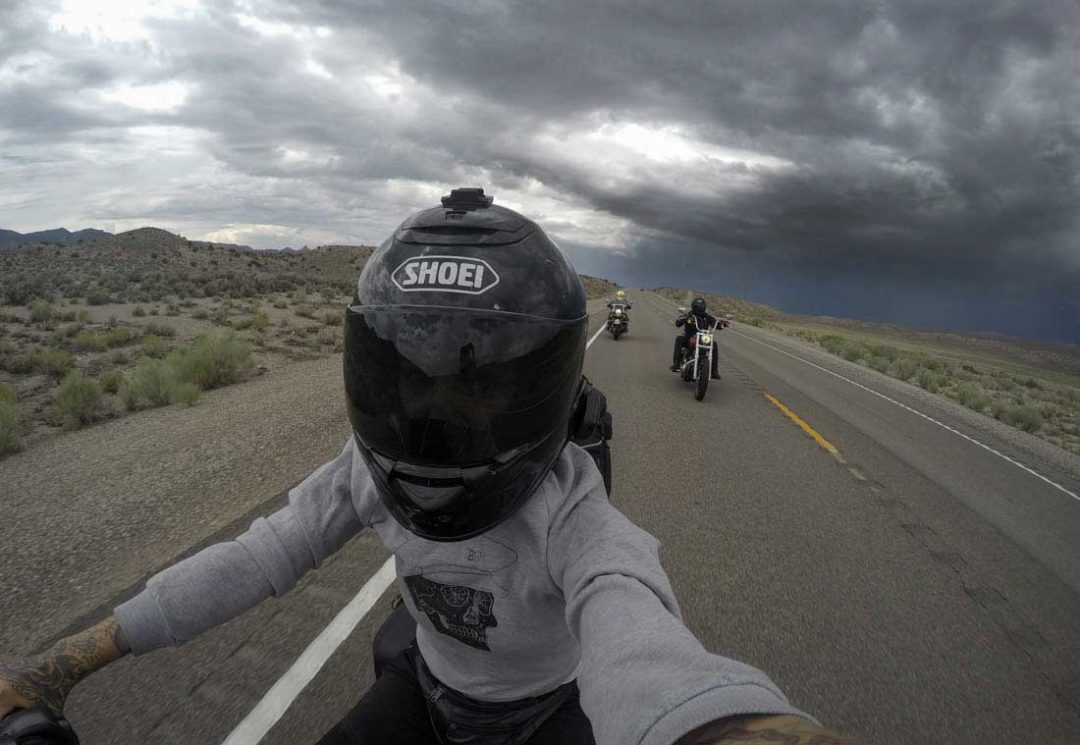
As we made our way south through the desolate wasteland that is the state of Nevada, we realized it had been naive to think we’d make it all the way home without hitting some bad weather. From one minute to the next, the sky was suddenly scattered with thunderstorms—when one disappeared behind us, another would take its place. For many miles, though, we somehow managed to not get hit by any rain. The tiny desert road we were on seemed to have been built specifically to avoid these hyper-localized storms.
Then, out of nowhere, a menacing wall of darkness appeared ahead of us, swallowing the road like it was a train going into a tunnel. It looked like something out of a movie. It was impossible to tell whether we were about to steer into the eye of a storm or a portal to another dimension. I was telepathically trying to urge Katie, who was leading the group, to stop and turn around. But there was nowhere to stop or turn, not even to put on rain gear. We had no choice but to keep moving forward, into the darkness.
Riding straight into this storm was one of the most terrifying and exhilarating things I’ve ever done. The temperature dropped noticeably. And between the golf ball-sized raindrops and the sudden absence of daylight, I couldn’t see more than a few feet ahead of me. Within seconds my clothes were completely soaked. I realized then that the open air filter on my bike was going to start sucking water into the motor. Forced to pull over on a narrow stretch of shoulder, I was silently praying that no cars would hydroplane into me while I put a cover over the air cleaner.
NOTHING MAKES YOU FEEL AS ALIVE AS PLUNGING HEADFIRST INTO DANGER AND ESCAPING UNSCATHED.
The storm only lasted for a couple of miles, but it felt like a lifetime. When I finally got out on the other side, I was overwhelmed by equal parts relief and adrenaline. I jumped off the bike laughing, fueled by a false sense of invincibility. Nothing makes you feel as alive as plunging headfirst into danger and escaping unscathed.
It was the first truly dangerous situation we’d encountered on this trip. So, it was only fitting that it would happen on the last day of riding before heading back to San Diego—when we’d let our guards down and allowed ourselves to think we’d already made it.
A few hours later, we were back in Las Vegas, stuck in rush hour traffic and surrounded by tall buildings and bright lights. It was a striking contrast to the last two weeks of being far from civilization and other people.
In just 14 days, we had ridden 4,300 miles through seven states and two countries. And rather than feeling relieved that we were almost home, we all agreed we’d rather turn around and head back through that storm than return to normal life again.
Meet the Author

Roadtrippers
Roadtrippers helps you find the most epic destinations and detours—from roadside attractions to natural wonders and beyond.
- Related Articles
- Latest Articles
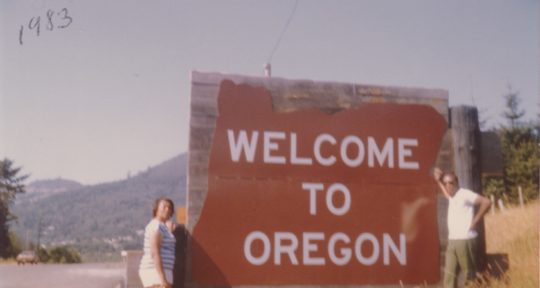
This Black couple spent 35 years traveling 96,000 miles by RV—now their granddaughter is sharing their story
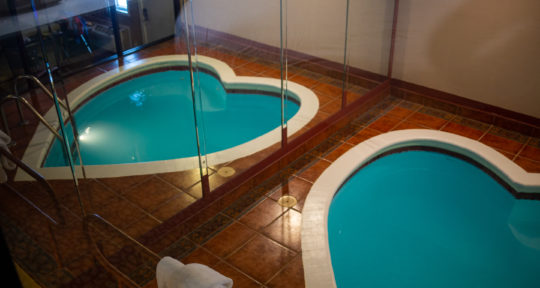
Kitsch, thrills, and disappointment: A solo honeymoon in search of a heart-shaped tub
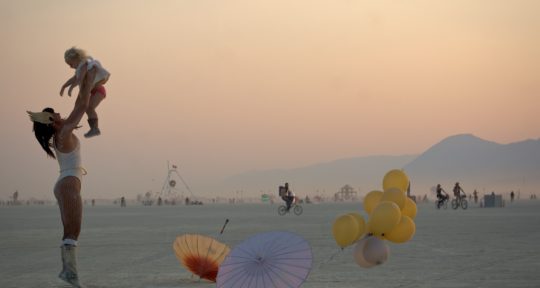
Burn, baby, burn: Meet the families who are raising Burning Man’s next generation of burners

The best festivals in the U.S.

What’s the Best AI Trip Planner?

Course: RV Maintenance Made Easy
Get the most inspiring stories from the road sent directly to your inbox..

- Trip guides
- Trip Planner
- Sign up Log in Sign out
- Log in Sign out
- ROADTRIPPERS MEMBERSHIP
- RV RESOURCES
Plan your journey, find amazing places, and take fascinating detours with our app.
We couldn't find an existing Roadtrippers account using that service. Please try signing in with another option or create a new account with Roadpass.
We need your email address to send you trip itineraries and other updates.
Cross Country Motorcycle Routes(and a packing list)

There is something uniquely thrilling and satisfying about touring by motorcycle.
If you are a motorcycle enthusiast , then the tremendous sense of freedom when hitting the road with your ‘baby’ is not foreign to you.
You know the electrifying sensation you feel as your motorcycle roars and vibration cruises all over your veins. There no words that can capture the heightened adventure and awareness as you sweep through twisties and curves.
Riding a motorcycle gives you the best way to get close to nature’s beauty. To feel the wind on your face; feel it as it plays with your hair. This thrill is second to none.
However, to fully enjoy the thrill of touring by motorcycle, you need to know which routes are the best. You need to know which roads will intensify your adventure by sheer beauty or fascinating landscapes.

Share this Image On Your Site
</p><p><strong>Please include attribution to Wandering Biker with this graphic.</strong></p><p><a href=’https://wanderingbiker.net/cross-country-motorcycle-routes/’><img src=’https://wanderingbiker.net/wp-content/uploads/2016/06/insane_motorcycle_rides_infographic-2.jpg’ alt=’Insane Motorbike Routes’ width=’800px’ border=’0′ /></a></p><p>
Other motorcycle routes you need to try
Routes in the united states.
There are millions of miles of roads in America. However, not all roads are the same. As a motorcycle enthusiast, it is important to note that there are roads, and there are motorcycle roads.
If you have a spectacular motorcycle road trip, then you should begin by finding out the best motorcycle roads and routes. This is because a great road will always lead to a great and fulfilling motorcycle ride.
With the numerous splendid motorcycle roads in the United States, choosing the top routes is always a hot button topic. It often provokes discussion with controversies and disagreement to present a top 5 or top ten roads in the United States.
Pacific Coast Highway, California

The Pacific coast highway, also known as California State Route 1, stacks favorably as one of the best motorcycle routes in the US. In fact, some motorcycle enthusiasts have labeled it the undisputed motorcycle route due to the smorgasbord of treats it offers.
The Pacific coast highway offers a scenic roadway like no other. If you decide to ride on this laudable motorcycle route, be ready to be mesmerized by the towering redwood forest, crashing surf, and seal-punctuated beaches.
You will also be glad to know that the Pacific coast highway offers you enough curves to spice up your trip and keep you contented end to end. The highway can be said to be a cliff-hugging ribbon that stretches 120 miles. On it, you will find frequent turnouts that will provide you with a golden opportunity to enjoy panoramic and stellar views.
The kind of stellar views you will feast your eyes on when you are riding on the Pacific coast highway will certainly whet your appetite for more. And this should not be a problem because the pacific coast highway is pretty extensive. It stretches pretty much the entire California coast; from Malibu to the Oregon border and beyond.
If you are planning on enjoying a motorcycle ride on the Pacific coast highway, it is advisable that you avoid it during summer weekends because Big Sur is famously fogbound. Additionally, make sure that you visit the Hearst Castle.
Tail of the Dragon, Tennessee

The tail of the dragon, also known as the Deal’s Gap, is another motorcycle route widely considered as one of the best motorcycle roads in America. The route is a Hollywood favorite and has been featured in several movies and TV shows including The Fugitive and Top Gear. The road got its notable name due to its striking simulacrum of a dragon tails.
The route boasts over 300 curves, and the sharpest curve has been given several nicknames including Gravity Cavity and Copperhead Corner. The rail of the dragon
Due to its exhilarating curves, you are sure to find motorcycle enthusiasts and die-hard sport-bike riders making a beeline on this road in a bid to test their cornering skills. And you don’t have to worry about an oncoming truck because no trucks are allowed.
There is a shrine, known as the Tree of Shame, which has motorcycle parts attached to it y those who were unable to tame the dragon. It is hence important that you just enjoy the curves without proving your bravado.
- Use a cooler for long road trips
Blue Ridge Parkway, Virginia

If you enjoy mountain route, then the Blue Ridge Parkway will definitely whet your interest. In fact, this iconic mountain route features almost on every serious motorcyclist must-do list.
The road snakes through the Virginia countryside featuring a fair share of local charms including the enthralling Civil War Battle sites. As you follow the route to the south, you will be ushered into the Great Smoky Mountains. Here, you will get to enjoy sweeping curves and eye-catching scenery.
The Blue Ridge Parkway has a compulsory 45-mile-per-hour speed limit, which is a good thing because it allows you to feast your eyes on all the view that reach a crescendo south of Ashville, North Carolina.
Although the parkway can be ridden in one day, it is recommended that you take two days. It is worth mentioning that there are no gas stations on the Blue Ridge parkway itself; you have to exist to fill up.
Bike Routes in South America
South America is a continent surrounded by Atlantic Ocean on the Eastern side and Pacific Ocean on the western side. It is possible to cycle across the continent, though they are not designated bike routes. You use the normal roads together with other road users. Cycling is in South America can be adventurous and fun, depending on the time of the year which determines the prevailing weather conditions. The South America circuit gives a visual outlook and appreciates the environment and all its surroundings. It takes less than 10 months to complete the cycling circuit from the South to the North.
Southern route
You can begin your route from the South at Marica Riohancha, Santa Marte; the coastal city in the Pacific Ocean. You then move to Peninsular, Venezuela to experience the sand beaches and great weather. The road takes you to Tierra-del Fuegro in the Caribbean Sea. It is 1,200 km stretch from the Southern City of Ushuaia. In Argentina, you will enjoy the wild animals from the parks and glaciers mountain of Perito Moreno and Mount Fitz Roy. From Tierra-del Fuego you move North road to Ruta 40 as you pass through Paratoginia; at this point you enjoy the woodlands of Chile and a green landscape of the grasslands.
Argentina route
Take Carrelera- Austria Road that has a gravel surface. Along the route you will encounter snow-capped mountains, rivers and their resultant features for an awesome visual look. This area lacks any facilities, when leaving the coastal city carry enough food and drinks. It is sparsely populated with lots of fishing activities and sight of Salmon and Trout fish species.
The road ends at the city of Puerto Mont, then go through Argentina to the sandy beaches of Andes. Rota 40 road still meets Mendoza to enjoy sea food and recreational facilities. You can ride north to Argentina to Salta town which is 400 km from Bolivia- a border town. The area is characterized by mountains and has a rough terrain making riding a difficult challenge. It has low temperatures of below -25 0 C and high altitudes. The area is remote with no recreational facilities though the people are friendly. At this point there are two routes:
Chile Route
It heads towards Chile in the Pacific coastline along Andes to Peru, Ecuador and Columbia.
Bolivia route
You can cross Bolivia towards the North then to Amazon- Brazil through the adventurous mountains. The area has friendly people with rich diversified culture and social welfare.
Southern Chile
All these routes lead you to Southern Chile and Peru in the North. In Andes the temperatures are average, it allows you to enjoy riding while site seeing the spectacular landscapes and geographical features. Finally, you cycle on Road BR319 with Jaguars and gorillas. They pose a threat but no need to raise alarm.
Cross Country Motorcycle Trip Packing List
Heading for a cross country trip, but want to make sure you are fully prepared? Preparation is key, as forgetting some important supplies could put a serious damper on your otherwise great trip.
To help you prepare for your journey, we have provided a packing list for you, listing all the things you simply must take during your trip. So, be sure to use our list before you head off!
Category 1: Your Toolkit
To ensure you do not get stranded in the middle of nowhere, you will need a toolkit containing tools for possible bike repairs or maintenance. Contrary to popular belief, these tools do not have to be heavy or cumbersome, since tools such as wrenches and grips are usually the ones necessary to execute emergency repairs.
When creating your toolkit be sure to include the following: wrenches (size 8, 9, 10, 12, 15, and 174 mm), vise grips, screwdrivers (flathead and Philips head), pliers, zip ties, battery O-rings, GPS fuses, and Allen keys.
Before you head off on your trip, always make sure you know how to use your tools. If you are not familiar with the tools or the emergency repairs you could be executing on the road, there is little point in taking a toolkit with you. So, do not only be prepared with tools, make sure you are prepared with knowledge too.
Category 2: Your Riding Gear
Riding gear is also an important part of your packing list. You want to make sure you are protected on the road, because no matter how good of a rider you are, you cannot account for everyone’s safety on the road.
When packing your riding gear, you must make sure the following is included in your kit: Roadcrafter (one-piece suit), a helmet, boots, boot laces, gloves (preferable two pairs, one for colder and one for warmer weather conditions), earplugs, and sunglasses.
Anyone who goes on a cross country motorcycle trip for the first time should pay extra attention to their riding gear. It is vital that your gear fits you perfectly, since an ill-fitting helmet or suit could do you more damage than good. If you are unsure about your riding gear, head to the nearest specialist store and ask for some assistance.
Category 3: Chain Maintenance Kit
When you go on a cross country trip, it is important to keep the motorcycle chain in excellent condition. While the supplies to maintain your chain could be considered as a part of your basic toolkit, we found it important to mention this as a separate category.
To be fully prepared on the road, you will need the following supplies to keep your chain in mint condition: several rags, a Teflon tube, WD40, specialist torque wrench and a 24 mm socket.
Please note that it is often recommended to keep your chain maintenance supplies separately from your toolkit. A lot of riders need these tools more often than the actual toolkit, so it may be a good idea to reserve a special place for these tools during your trip.
Category 4: Heated Riding Gear
Depending on where you are going on your cross-country trip, you may need some heated gear. With heated gear, you are more prepared for cold weather conditions, so ensure you include them. It is also advised to keep heated gear separately from your regular riding gear; this makes it easier to find while on the road.
As a part of your heated gear kit, make sure you include a warm jacket that will also provide you with ample protection in case of a crash, socks, wire for heated socks, warm gloves, and a HeatTroller.
Please note that not all riders will require heated gear during their trip, but it is recommended, nonetheless. The weather can be very fickle, so even when there is little doubt you will encounter severe weather conditions, it is always better to be prepared.
Category 5: Tire Maintenance
Much like the chain of your motorcycle, your tires will require maintenance somewhere along the way. Fortunately, there are some basic supplies you can keep on you to ensure you can keep going. Essential tire maintenance supply for your packing list include a tire gauge, cycle pump, gator clips for the pump, and a tire plug kit.
Category 5: Electrical Supplies
In this day and age of technology, most riders will have some gadgets with them. While there are some riders who do not take any, most riders enjoy having some technological conveniences along the way.
Most riders will add the following electricals to their supply kit: GPS, USB cable, cell phone and accompanying charger, digital camera and charging cable, laptop and adapter. Please note that you are not required to take all these supplies. Some take photographs with their smartphone, and other like to leave bulky items such as a laptop at home. Electricals are a more personal choice, although we do recommend taking a good GPS just in case.
Category 6: Legal Documents
When you are on the road, there is a chance you will be asked to display insurance or your driving license. Therefore, these documents must be easily accessible during your cross-country trip and must be included on this list.
Essential documents you will require on your trip include: your driver’s license, registration, insurance documents, passport or identification cards, paper, and a pen.
Category 7: Miscellaneous
There are other essential supplies to be taken on your trip, but they often do not have their own category. That being said, you cannot forget to bring these items, as they are bound to prove essential during your trip.
One of the essentials you cannot forget on your trip is a first aid kit. While you may not be in an accident, it is not uncommon to get a cut or a graze. To ensure you can remain comfortable, ensure you have essentials such as plasters, bandages, and antiseptic in case of a medical emergency.
In addition to your first aid kit, you must also consider any medications you should be taking with you. For example, if you are an asthmatic, you should be keeping your inhalers in an easy to reach place. It is also advised to take supplies such as painkillers, which could prove rather useful if you get a rather annoying headache somewhere on the road.
Toiletries is another thing to consider for your trip, in addition to your regular clothing of course. Essentials to include are a towel, brush, toothbrush, toothpaste, sun lotion, bug repellant, a razor (if you need one), soap, lenses and glasses if you wear them (it can also be useful to bring a spare pair).
When packing your miscellaneous bag, make sure you consider the clothing you are going to take. You will need several pairs of pants, socks, shirts, underwear, and other essential clothing you will need on the road. Also make sure you are prepared for all weather conditions.
Finally, always take a spare bike key with you. When on the road, it is certainly not uncommon for things to get lost or stolen. The last thing you need is getting stranded with no way to start your bike, so make sure you have a second set of keys in your miscellaneous bag.
Category 8 (Optional): Camping Supplies
Please note that this category is optional, since not all riders decide to camp during their cross-country ride. Some prefer to stay in hotels or motels along the way, so this category is only useful f or those who want to experience the beauty of outdoor camping along the way.
Camping materials can be cumbersome and heavy. Since you are already taking a bunch of supplies with you on your trip, it is essential to pack smart, but not leave behind any essentials to remain comfortable.
When you decide on camping along the way, please ensure to include the following supplies in your camping bag: a tent, durable sleeping bag, tarp (which can shield you or your bike from the weather elements if required), headlamp, and a pillow.
Welcome to my Site!

Hi, I'm Teddy! I started this site along with two other friends and fellow roadhogs, Lee and Normberg. Together we document the state of the motorcycle industry, our travels together, and other random things. Enjoy!
Essential Motorcycle Gear

Packtalk Edge
- Packtalk Neo
- Packtalk Custom
- Adapter for SHOEI Helmets
- Freecom/Spirit Half Helmet Kit
- Packtalk Edge 2nd helmet kit with Sound by JBL
- 2nd Helmet Kits
- Half Helmet Kits
- Replacement Units
- Spare Parts
- All Accessories

Packtalk NEO
- Packtalk Outdoor
- Packtalk Outdoor Instructor Set
- Packtalk Outdoor – Single Student Kit
- Packtalk Outdoor – Single Instructor Kit
- Packtalk Outdoor 2nd Helmet Kit
- All Outdoor Accessories

PACKTALK OUTDOOR

PACKTALK OUTDOOR INSTRUCTOR SET
- Packtalk Edge ORV
- Packtalk Edgephones ORV
- Packtalk Edgephones
- All Off-Road Accessories

PACKTALK EDGE ORV

EDGEPHONES ORV
- Product Support
- Product Comparison
- Shipping Policy
- Returns & Cancellation policy
- HR 4 People
- Dealer Locator
- About Company
- Cardo Journey
- Sustainability
- Distributor & Dealer Zone
- Dealer Support
- Dealer Signup (US only)
- Outdoor Dealer Signup (US Only)
- First Responders and Military
- Ambassadors
- Cardo Connect
- Main Products
- Popular Accessories
- About Cardo
- Partnerships
STAY UP TO DATE
Subscribe to our newsletter to get news and exclusive deals!
Your cart is empty

Cross Country Motorcycle Traveling
There are a thousand different reasons why generations of motorcycle riders have considered the cross country trip to be a rite of passage. A cross country motorcycle trip is an incredible way to get a more intimate knowledge of your bike, your traveling companions, the landscape around you and even yourself. And, yes, when you’re out there on the road with your bike, you’re probably simply going to feel like a little bit of a badass, which is a pleasure in its own right.
The truth is, though, that the most successful cross country motorcycle trips are often also the best-planned ones. Planning doesn’t mean removing all spontaneity from your trip, but it does mean having a general idea of where you’re going, where you’re staying and other basics of any successful road trip. A little bit of effort put into planning will turn into a big payoff when it comes to enjoying your journey.
Overwhelmed by all of the factors of planning a cross country motorcycle trip? You’re not alone. Here are the essential questions that you need to answer to give your cross country trip a strong start.
Where Are You Going?
The first essential question you have to answer is what the endpoint of your journey will be. Having trouble choosing a destination? Here are some ideas that might get your motor running:
– A friend you haven’t visited in a long time
– A famous landmark you’ve always wanted to see
– A national or state park that you want to hike or camp
– One or more states you’ve never visited before
– A motorcycle rally or other event for riders
Any of these options make a perfect destination for a cross country motorcycle trip. When choosing your destination, however, be sure to think about whether your destination is realistic for a rider of your skill level. There’s nothing wrong with pushing yourself to a higher level, but if you’ve only been riding for six months, a coast-to-coast trek probably isn’t the ideal first long distance ride.
Talk to your other friends who ride motorcycles about rides that they’ve enjoyed and ask them whether your destination and timetable are realistic. Get some recommendations from them about the coolest places to go, because if they’re like most bikers, they’ve got a few recommendations that they’re dying to share.
International travelers have a unique set of things to think about, including passports, visas, currency and local cultures. See our guide to planning a motorcycle trip in Europe for advice on navigating popular destinations across the pond.
How Are You Getting There?
When you’re on a motorcycle, the quality and design of the roads are just as important as (if not more important than) where the roads go. Part of your plan of attack for your cross country tour should be deciding which roads you’ll take and researching what they’re like. Here are some of the big factors to think about:
– Whether you want your route to include tight, curvy sections that will test your riding skill
– Whether you want to explore famous motorcycling roads (such as the Three Sisters or Tail of the Dragon)
– Whether your bike can handle unpaved roads or needs good smooth pavement
– Whether you want to ride on major highways or smaller, more scenic backroads (or a mixture of both)
– Which roads will give you the scenic views you crave
– How quickly you want to arrive at your destination
Motorcycle trip planning apps and websites can help a lot here. Many apps, like Calimoto and Scenic Motorcycle Navigation , even allow you to select the level of road curviness you want on your journey. These apps also typically include user commentary that will help you identify rider-friendly roads with good scenery.
When Are You Going?
You’ll want to think carefully about the dates for your trip. If you’re headed to a particular event, like a wedding or family reunion, try to leave yourself at least an extra day in case something comes up. When considering how much time you need to take off work, don’t cut it so closely that you risk being late if you’re not exactly on schedule.
It’s especially important not to push yourself too hard if you’re relatively new to distance riding. Riding for long stretches can take a lot out of you, and you can put yourself in a dangerous situation if you push yourself to keep riding when you’re too tired and sore to concentrate. When in doubt, get off the road, and plan your trip so that you have time in your schedule to do it.
Most likely, your trip will fall within the typical riding season dates of (loosely) March through November. Remember that one month can feel really different from one region to another, particularly in the fall or spring. A ride that starts in a balmy Florida March can lead you into a snowstorm if your destination is Chicago. Pack the gear that makes sense for where you’re going and be prepared for conditions to change.
Who Are You Going with?
The pack you’re riding with can be a true make or break factor for a cross country motorcycle trip. Give careful consideration to who you want to bring along on your journey because you’re about to spend a lot of time with them.
Of course, there’s nothing wrong with going solo on your cross country trip . It can be an amazing and rewarding experience to face the roads alone with just you and your bike. However, you’ll need to take some extra steps to keep yourself safe, such as having a buddy who you check in with regularly at the end of your day’s travels.
If you are bringing friends, you want to ride with people you know and trust for a major undertaking like a cross country ride. Choose people who know your riding style and who are experienced, competent riders in their own right. Someone who’s relatively new to riding may struggle with the long days and physical exhaustion of cross country riding.
If you’re bringing a passenger who will be riding on your bike, it’s important that the two of you are already familiar with riding together. Every bike and every rider are different, and riding as a passenger is a skill of its own that has to be practiced.
Finally, make sure you have an easy way to communicate with the other people in your group. A motorcycle communication system like one of the Cardo Packtalk or Cardo Freecom helmet intercoms is an ideal choice. These devices keep your group locked in at all times through state-of-the-art wireless communication.
What Bike Are You Riding?
Most riders prefer to do long distance rides on cruisers, touring bikes or bikes that are otherwise designed for long haul riding. These bikes tend to have features that make distance riding easier, such as an upright riding position, forward-set footpegs and a comfortable seat. Touring bikes, in particular, are specially designed for the job – with features like built-in saddlebags.
While it’s certainly possible to do a cross country trip on a sportbike, you’ll need to do some preparation to make the experience comfortable and fun. Consider adding some mods like clip-on handlebars to take pressure off your wrists or a more padded seat to keep you comfortable. Pay careful attention to your packing list so that you don’t add too much weight to the bike, and use saddlebags or tank bags rather than a backpack.
It’s critically important that your bike gets an inspection and mechanical wellness check before any long trip. Take it to a trusted mechanic or do it yourself if you have the garage skills. And think carefully about taking a trip on that classic project bike that’s always breaking down. As romantic as an old-school bike might feel, it’s better to have a reliable bike that won’t leave you stranded when you need it the most.

What Are You Bringing?
Visit any motorcycle forum and you’ll find riders debating the ultimate kit for a cross country trek. However, there are a few key road trip essentials that just about everyone agrees on.
– Protective Gear: Helmet, boots, jacket, gloves — if you don’t have all of these motorcycle gear essentials already, it’s time to get your kit in shape. Your road trip gear should be designed for comfort and preferably already broken in. And don’t forget the rain gear in case you get stuck in a downpour.
– Saddlebags: Give careful consideration to the kind of saddlebags you pack your gear in. Hard cases are a great idea to give your stuff maximum protection from adverse weather. If you’re not used to riding with saddlebags, make sure to take a few test rides on your fully loaded bike, as it can significantly alter the bike’s balance and handling.
– Water and Snacks: Keeping your body nourished on the road is essential for a fun and safe road trip. Bring a rugged water bottle and some non-perishable snacks that will keep you sated during rest stops. Beef jerky and granola bars are classic options because they pack light and provide lots of energy and nutrients.
– Basic Tools: You need to be able to take care of basic repairs while you’re on the road. A multi-head screwdriver, flat kit and small ratchet set will take you a long way.
– Map: If you’re going through rural areas, your smartphone may not always have service when you need it. A satellite GPS can be an improvement, but the most reliable option of all in an emergency? A compact road atlas to slip into your bag.
– Helmet Communication System: A bluetooth motorcycle helmet speaker system like the Cardo Packtalk Bold will allow you to do everything from shooting the breeze with your fellow riders to jamming out with your favorite music. As previously mentioned, getting a good motorcycle communications system is especially important if you’re riding in a group.
– Ear Plugs: The constant noise of your engine and the wind together can be damaging to your hearing (not to mention annoying) when it’s going on for eight or more hours a day.
– Spare Key: For the relatively small cost of a duplicate, you can save yourself the embarrassment and anguish of having to have your motorcycle transported hundreds of miles back to your home base because you can’t find the key.
These aren’t the only pieces of gear you’ll need on the road, but they form a solid backbone for any road trip kit.
Where Are You Staying?
Riding a motorcycle cross country will leave your body ravenous for sleep at the end of the day, so it pays to do some advance consideration of where you’ll lay your head at night. Generally, you’ve got two types of options: camping or sleeping inside (whether at a hotel or with friends).
Motorcycle camping can be a lot of fun, and it’s particularly good if you’re planning to ride through scenic areas. If you’re planning on camping, make sure to check out our ultimate motorcycle camping gear checklist for more essentials that will make your wilderness experience a success.
However, keep in mind that your body may appreciate having a real bed to sleep in if you’ve just spent a long day riding. Springing for a hotel can make a big difference in how refreshed you feel when you wake up.
If you’ve got friends you can stay with for a night, even better! Just make sure that other members of your group have a place to stay lined up, and remember to make sure there’s a safe place to park your bike.
Your unforgettable motorcycle road trip experience is out there waiting for you — now, you just need to get the pieces in place to make it a success. And while you’re at it, check out some of the latest innovations in bluetooth motorcycle helmet technology so that you can stay connected throughout your cross country tour.
Continue reading

How to Start a Motorcycle Club
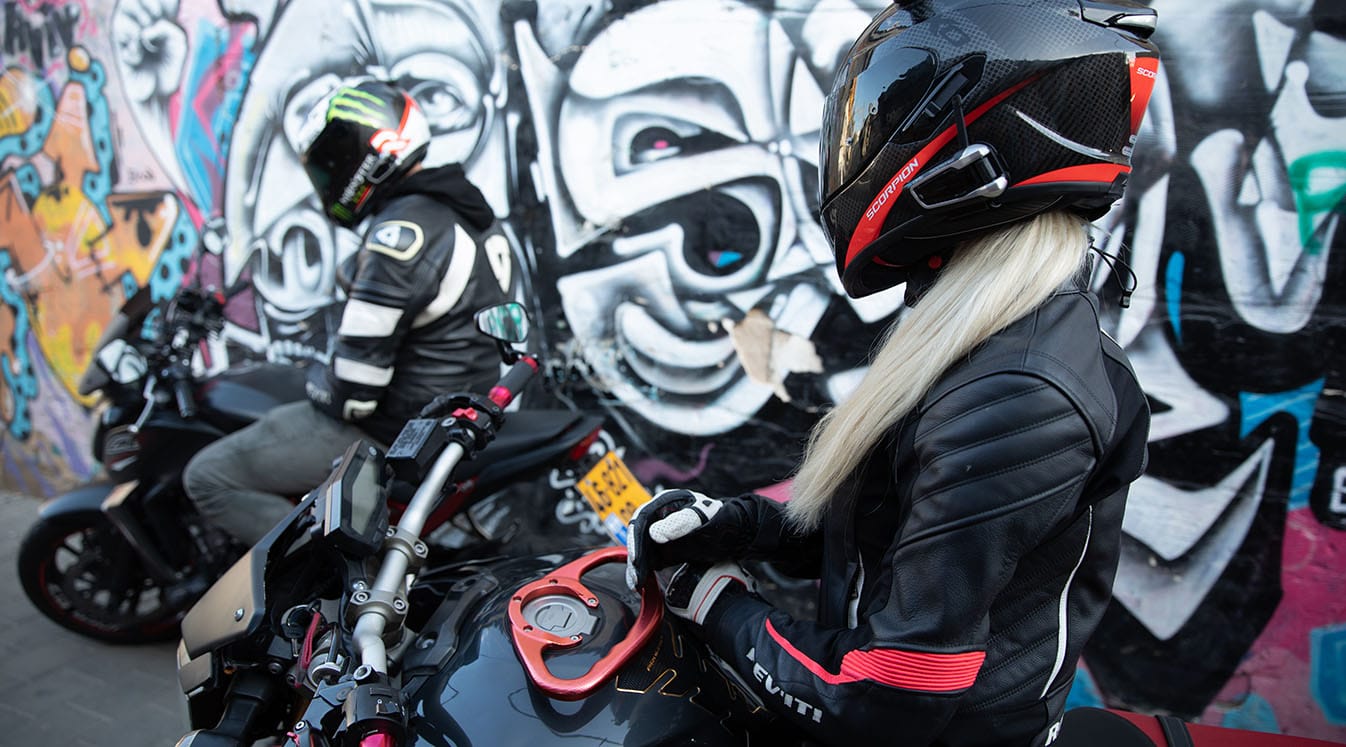
How to Measure for a Motorcycle Helmet
- Skip to main content
- Skip to secondary menu
- Skip to primary sidebar
- Skip to footer

Biker Report
News and More for Motorcycle Riders
15 Tips for Your First Cross-Country Motorcycle Trip
April 5, 2023 By Alen Schnell
Are you eager to hit the open road on your motorcycle for an unforgettable adventure ? Proper preparation is crucial to not only savor the journey but also ensure safety and tackle challenges such as unpredictable weather and wind noise.
We’ll present 15 expert tips to help make your first cross-country motorcycle trip a memorable and rewarding experience. Covering everything from weather-proofing your gear to minimizing wind noise, we’ve got all the bases covered. So, let’s gear up and embark on the ride of a lifetime!
1. Plan According to Your Experience
When mapping out your cross-country motorcycle trip, it’s essential to be realistic about your riding abilities and stamina. Consider your physical and mental limits, as well as your experience with long-distance riding.
If you’re new to extended trips, start with shorter daily rides and gradually increase the distance as you gain confidence and endurance. Factor in breaks for rest, stretching, and meals to maintain your energy and focus throughout the day.
Adjust your route to include varying road conditions and terrains that match your skill level , and avoid overly challenging or unfamiliar paths that could prove dangerous. Remember that it’s better to take a longer, more enjoyable trip than to push yourself beyond your limits and risk injury or fatigue.
By planning according to your experience, you’ll ensure a safer and more enjoyable journey on the open road.
2. Create a Well-Equipped Packing List
Pack all your motorcycle riding essentials . This includes your cell phone, charger, first aid kit, tire repair kit, reusable water bottle, portable motorcycle cover, physical map, laundry pods, lightweight clothing, extra socks, cash, and sunglasses. Also, pack waterproof clothing , such as rain pants, a rain jacket, and gloves for weather protection.
Be mindful of your motorcycle’s weight restrictions when packing. A well-equipped tool kit, including wrenches, pliers, a tire pressure gauge, a flashlight, and a multitool, is indispensable. Carry spare parts like extra fuses, spark plugs, and clutch or throttle cables for unexpected breakdowns or repairs during your journey.
3. Double-Check Your Bike
Before hitting the road, ensure your motorcycle is in top condition . Have a mechanic examine the frame, suspension, engine, and transmission. Don’t forget to check your helmet, tires, and load limit.
The owner’s manual should state the Gross Vehicle Weight Rating, and it’s crucial to stay under the maximum limit. Consider investing in a high-quality waterproof cover for your bike to protect it from rain and other elements during overnight stops.
4. Understand the Legalities of Each State
As you pass through different states on your cross-country motorcycle trip, you’ll encounter varying rules and regulations . From differing speed limits to motorcycle-specific laws, it’s crucial to be aware of and comply with the legalities in each state.
Research motorcycle helmet requirements , lane-splitting laws, and noise restrictions to avoid potential fines or penalties. Familiarize yourself with local traffic laws and customs, such as refueling protocols or unique right-of-way rules.
Carry a variety of government-issued identification, like your driver’s license, health card, and a copy of your passport, to ensure a smooth journey. Staying informed about each state’s legalities will not only keep you safe but also help you avoid potential trouble during your trip.
5. Download Travel Apps and Prepare for Navigation
A variety of travel apps can enhance your cross-country motorcycle trip experience, helping you save time, money, and effort . Download apps like Google Maps or Waze for reliable navigation, and familiarize yourself with their features and offline capabilities before your journey. This way, you can still access your routes even when you lose internet connectivity.
Accommodation and fuel apps like Booking.com , Airbnb , and GasBuddy can help you find the best deals on lodging and the cheapest fuel stations nearby. Additionally, consider apps like Roadtrippers or Scenic that suggest scenic routes, must-see attractions, and biker-friendly stops along your journey.
Weather apps like Weather Underground or AccuWeather can provide real-time updates on weather conditions, helping you plan and adapt your route and gear accordingly. By downloading these travel apps and preparing for navigation, you’ll stay informed, connected, and ready to tackle any challenges that come your way during your cross-country motorcycle adventure.
6. Have a Reliable Method of Communication
Carry a working phone with coverage in all planned destinations. Invest in a sturdy, waterproof phone mount for your motorcycle so you can easily access your device while riding. Be sure to carry a portable power bank to keep your phone charged during long stretches without access to electricity.
7. Choose the Right Helmet and Consider Bluetooth Connectivity
One crucial aspect of your cross-country motorcycle trip is selecting the right helmet. It should not only meet safety standards but also provide comfort during long hours on the road. Consider a helmet that offers good ventilation, a clear visor, and a snug fit to ensure your safety and comfort .
Moreover, think about investing in a helmet with Bluetooth connectivity or purchasing the best motorcycle headphones for your trip. Bluetooth-enabled helmets or headphones allow you to wirelessly connect your smartphone, enabling you to listen to music and podcasts or take calls while keeping your hands on the handlebars.
This feature also comes in handy when using GPS navigation, as you’ll be able to hear turn-by-turn directions without having to constantly glance at your phone or GPS device.
8. Pack Earplugs for Wind and Road Noise
Reduce wind noise and protect your ears during long stretches on the interstate. Long exposure to wind noise can cause hearing damage or discomfort, so having earplugs handy is essential .
9. Don’t Press Yourself for Time
Allow ample time for breaks and exploration, ensuring a relaxed and enjoyable trip. Embrace the slower pace of life that a cross-country motorcycle trip offers, reminiscent of the Zen approach in the book “Zen and the Art of Motorcycle Maintenance.”
Give yourself enough time to savor the unique experiences and attractions along the way, as you immerse yourself in the journey rather than solely focusing on the destination.
10. Be Prepared for Weather Changes
Unpredictable weather can affect your ride, so it’s essential to monitor the forecast and make necessary adjustments to your gear and schedule. In addition to waterproof clothing, consider investing in heated gear for colder temperatures and moisture-wicking layers for hot days.
Be prepared for weather changes to keep yourself and to also ensure a safer and more enjoyable journey.
11. Stay Hydrated and Well-Nourished
Maintaining proper hydration and nutrition is vital for a successful cross-country motorcycle trip. Pack healthy snacks and a reusable water bottle to ensure you have easy access to water and food throughout your journey. Take regular breaks to refuel your body and replenish your energy levels.
12. Avoid Excess Interstate Routes
Choose scenic back roads over faster interstate routes to fully enjoy the journey. Planning your trip around picturesque routes and iconic landmarks will make your adventure more memorable and enjoyable. Use online resources to research popular motorcycle routes that have been tried and tested by fellow riders.
13. Document Your Journey
Capture your adventure by taking photos, journaling, or recording videos. Documenting your trip not only helps you preserve memories but also allows you to share your experiences with friends, family, and fellow motorcyclists. Consider using a helmet-mounted action camera to record your rides from a unique perspective.
14. Connect with Fellow Riders
Join motorcycle clubs, forums, or social media groups to connect with other riders who share your passion. Meeting and learning from fellow motorcyclists can enrich your cross-country experience, provide valuable advice, and even lead to lifelong friendships.
Additionally, be sure to visit the best biker bars along your route to mingle with like-minded individuals and create lasting memories of your epic journey.
15. Stay Safe and Ride Responsibly
Prioritize safety by adhering to traffic rules, respecting speed limits, and wearing protective gear. Keep an eye on weather forecasts and avoid riding in extreme conditions. Be prepared for unexpected situations and trust your instincts. If you feel tired or unwell, take a break or call it a day.
Your First Cross-Country Motorcycle Trip
Embarking on a cross-country motorcycle trip can be the adventure of a lifetime, creating unforgettable memories and exhilarating experiences. By following these expert tips, you’ll be well-prepared to enjoy your journey safely and savor every moment, from breathtaking landscapes to the symphony of exhaust notes along the way.
Happy riding!

About Alen Schnell
Writer, Editor, and Motorcycle Enthusiast here at Biker.Report. Follow me on twitter or facebook .

- Terms of Service
- Privacy Policy
- How We Make Money

- Packages & Tours
- Eaglerider \
- Information \
30 Essential Motorcycle Touring Road Trip Tips
Posted On: Oct 17, 2018
Start a Reservation
You arrive to a new destination, the motorcycle is waiting for you with a welcome card that has your name on it, and you’re barely containing the excitement before the adventure begins. Some of us enjoy the trip planning process as much as the ride itself.
Thinking through the details, making the perfect route, and packing for the trip are all essential. There is no doubt that every trip needs a personal touch, so there will be a variety of opinions and advice you’ll get as you tell more people about the trip you want to do.

Years of experience and thousands of happy customers can tell you that when it comes to motorcycle travel, EagleRider is the top choice. We put together a list of our top 30 tips for motorcycle touring and riding a motorcycle across the country. We hope this list helps you plan you ride, whether you do it with EagleRider or on your own. This list of touring tips will get you started on some key things you need to arrange for your upcoming adventure.
TRAVEL TIPS
1. set the date – commit to the trip.
Someday can be today. Thousands of riders dream of getting on a bike and doing a trip, whether it’s 3 days or 30. But mostly the dream ends there. Family commitments, work, finances, and so many other things get in the way that dreaming is what most riders surrender to. It doesn’t have to be this way. Plan ahead and set the date. Commitment is the first step.
Having flexible dates won’t help you secure travel, visas, motorcycle rental, or anything else. It won’t help you get a buy-in from your family to do the trip. Firm travel time is necessary because you’ll be able to plan everything else around it.
2. Ride your own bike/rent/tour – how to know which one
There are three main options for riding anywhere:
- Do it on your own bike
- Rent/borrow one
- Do a self-drive or a guided tour
Which one works for you ultimately is a personal preference. GUIDED TOURS are more expensive, but also take care of most of the logistics and travel arrangements. You trust that you’re with an experienced guide who knows the local areas and you are also looking forward to exploring the new land with like-minded motorcycle riders.
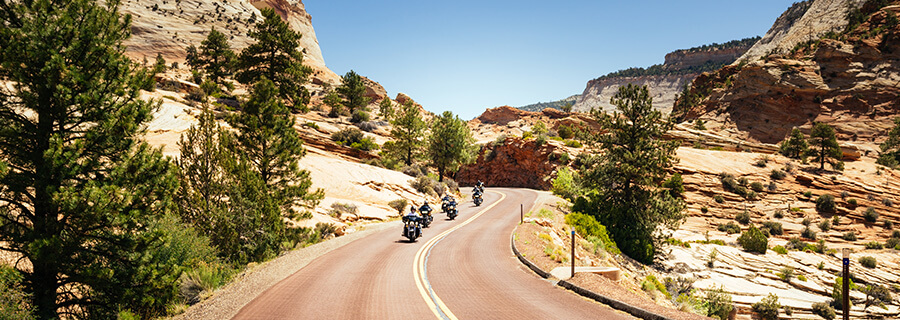
Renting a motorcycle is becoming easier as we and other motorcycle rental companies offer a variety of makes and model at numerous riding destinations. Rental gives you the freedom to keep a pretty open daily riding schedule and riding your own bike is the cheapest option.
You can absolutely ship your bike across the ocean if you live overseas, but it’s not going to pencil out financially in most cases.
Creating your own custom route can take a lot of time and is also a fun experience. You get to learn about new places, get insights from other riders, and pick the pace of travel that works for you. At EagleRider, we have a team of tour architects that can assist with route planning for your rental or custom tour.
3. Best time to ride – early summer, early fall
We get asked every day about the best time to ride a certain route, such as ROUTE 66 and our WILD WEST tours. Your trip can be anywhere in the world and most likely you will face a variety of weather and riding conditions. But for riding in America, there are definitely several windows of perfect weather: early summer and early fall.
In winter you can enjoy Florida and the Southwest, or even do a tour down to Cabo San Lucas in Mexico . Our guide to winter riding offers all the best routes and trip suggestions. Summer offers a must consistent level of temperatures and in the desert areas, you’re very likely to face extreme heat. Not everyone is ready for that, so some riders opt-in to ride in months that are a bit cooler.

There is no single answer to this, especially if your trip is 3-6 months long across multiple continents. But for most 2-week trips, early summer and early fall offer a really nice mix of temperatures. If you want to save a buck, Shawn offers some great tips for this in his Q&A Q&A about navigating EagleRider products .
4. Motorcycle with ample storage that fits your riding experience and preference
How to pick a motorcycle is one of those questions that we can spend hours contemplating. It’s very difficult to recommend something because we all have different riding preferences and levels of experience. Some bikes are great for touring but can be too heavy especially with a passenger and full touring packs with clothes.
The best suggestion you can get is to look at motorcycles that fit your riding experience and have enough storage for the trip you are planning. We put together a detailed guide on choosing the right bike for your trips, which will be a great reference point for your upcoming adventures. On a guided tour our van carries all the luggage, but on a camping trip, you’ll need to carry everything in your saddlebags and attached to a sissy bar.
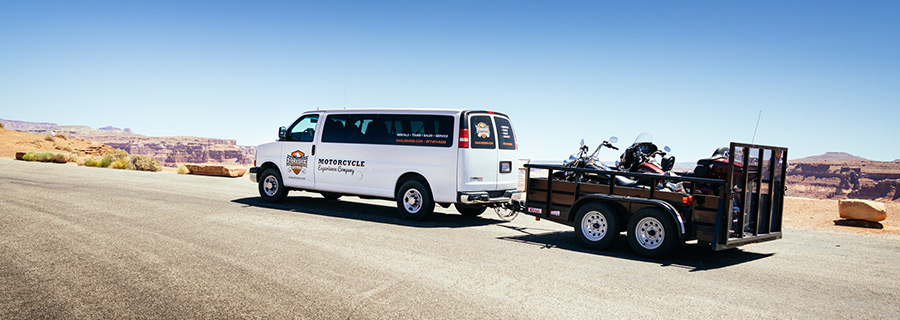
In general, most riders prefer bigger touring bikes for 7+ day trips, but you should only ride a bike that you are comfortable handling. For off-road riding, there is a completely different set of features you’ll be considering compared to perfectly maintained roads and highways of the USA.
You can always contact us and explain what trip you want to do and your preferences for a motorcycle and our team of seasoned riders will assist with recommending a few models that we think will work well for you.
5. Route 66 is not the only way to cross the country
There are thousands of ways you can cross America, from Route 66 to Pacific Coast Highway

We offer 100+ pre-defined routes, all of which can be further adjusted based on your wishes. Some of our most popular routes besides the best selling Route 66 full tour , include:
- Triple B – Blues, Bourbon, BBQ (New Orleans to Washington DC)
- Coast 2 Coast Motorcycle Tour (Los Angeles to Orlando)
- Western Coast - P acific Coast Highway (Seattle to Los Angeles)
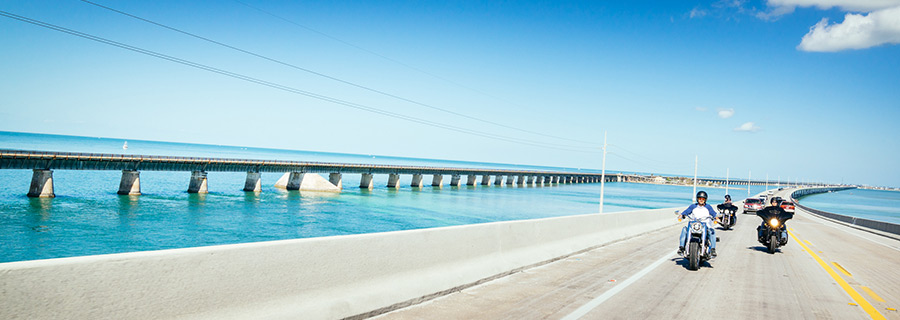
Many of our riders extend their trips to Sturgis and begin riding on either coast to then spend a week in South Dakota and after continue riding across the country. If the time allows, adding a few days at one of the iconic motorcycle rallies is a great way to spice up your trip and celebrate the life on two wheels with fellow riders.
6. Share your ride with others - take photos and videos along the way
Did you know that the most watched motorcycle videos on YouTube often are of the long cross country and cross-continent rides?
Following someone’s adventure through the lens of the camera or smartphone is better than not seeing it at all. Let your family and friends enjoy the road with you, share your ride on social media and your site if you have one.
There is a variety of apps and websites that allow for route sharing and you can also post images and videos along your favorite stops and moments on the road. The main thing is to share what you see with others. During or after the trip - your choice, but capturing moments on the road will make for a nice souvenir many years later.

Don't forget to tag #eaglerider when you share your photos and videos on social media. Every month we pick a random lucky winner and award $300 gift card towards future reservations on eaglerider.com.
CLOTHING/GEAR TIPS
7. pack small.
We can be very different in how much packing we want to do for a trip. Some of us carry suitcases with three sets of clothes for every day. Some of us pack the side case bags that fit inside Electra Glides that what’s all the clothing for 2-3 weeks.
Mostly everyone always recommends packing small. Everything you may want on the road can be purchased with cash or credit card. In many cases, too many things to carry become a burden. Even if you’re packing for a month-long camping trip, you need to pack down to the minimum essentials to have room for everything. See our packing checklist and guide for more info.
Generally, bring twice as much cash and half the clothes you think you’ll need. Riding cross-country will take you through dramatic shifts in elevation and temperature. Mountain passes can have freezing temps and snow, even in summer. If you come from an area where there are no significant changes in elevation, it’s hard to wrap your head around entire climate zones existing at certain elevations. It’s simple—be prepared for everything.
8. In desert areas, keep long sleeves on
It’s a common misconception that you can ride through a desert in just short sleeves. We always recommend keeping long sleeves on, for a few important reasons:
- You don’t want to have your body having direct contact with the sun
- If you do, you get dehydrated quickly and can compromise your ability to control and balance the motorcycle safely
- Common symptoms after that (aside from sunburn) can include nausea, dizziness, muscle weakness and cramping, and many others leading up to a heat stroke
- Protect your body from the sun, don’t open yourself up to harmful UV rays

It’s something we see very often, especially in our Southwestern locations. The riders drop off the bike with the happy sunburned faces tell us all about their adventures. Even though the effects of the extensive sun exposure seem to disappear fast enough, it’s the long-term effects that you should also consider.
9. Weatherproof bags and rain gear will save you in most unexpected situations
If you have a support vehicle following you (e.g on our guided tours), you can skip this one. But if not, chances are you’ll be carrying some kind of a bag on a sissy bar. The best way to protect your packed gear is to have weatherproof bags. Weather changes, sometimes within hours. When you get to your overnight stay, the worst thing is to have not only yourself soaking wet, but also all your fresh clothing for the trip as well. It may seem like an exaggeration right now, but one piece of advice we always have for riders is to pack a quality set of rain gear and think through the carry options ahead of time.
10. Wear Coolmax or other moisture wicking materials instead of cotton shirts
There are mixed opinions about whether cotton is a proper way to dress is in the extreme heat conditions. Mostly coming from hikers and adventure travel enthusiasts, there is a popular belief (with scientific reasoning) that cotton traps the heat close to your body while moisture-wicking materials don’t stop the heat from releasing helping you to keep the body temperatures at an optimum level.
Polyester holds on to only about 0.4% of moisture while cotton holds around 7%. That’s a big difference. Newer technologies, what’s commonly called base layers, force the moisture out of the garments through the special weaves of the fabric. Your body stays dry and maintains its temperature balance while your clothes protect from the elements and release the heat and sweat.
A variety of brands make motorcycle-specific base layers, you can shop for these options online ahead of your ride.

11. Layering is the best way to dress/pack
The secret to packing and surviving any weather is layering. Not only this is the easiest way to adjust in rapid temperature changes, but also to save space when packing. For most motorcycle trips, you really need a few sets of warmer sweatshirts and base layers. One jacket, especially with multiple air flow zippers and vents will be sufficient for most rides.
12. Don’t bring expensive glasses
Eye protection is essential for any motorcycle ride. Shatterproof glasses or a helmet with a built-in sun visor are the two best ways to stay protected and ride comfortably in all hours of the day. Expensive glasses will be a shame to lose or scratch. They’re also not the safest option as rider’s head/helmet is often the first area of impact in accidents.
13. Rolled up clothes take less space
We all probably have this one friend who’s always packing with compression cubes, individual pouches for shoes, and everything in very neatly rolled tubes. Most of us are not line this. But… it’s been proven over and over that rolled up clothing takes less space and has very few wrinkles when unpacked. From military duffle bags to modern hikers and motorcycle riders, everyone finds this way of packing to be very efficient. Give it a try.
14. Small camera or phone are better that a DSLR
Everyone is a photographer these days. The trap that most people fall into is buying big bulky camera (“best on the market”) and then struggling to take photos with it during moto adventures. In general, mirrorless cameras are much more compact and offer amazing image quality for half-the-size.
The best camera for motorcycle touring, just as it is for any other activity, is the one that you have quickly available. That can be your phone or a small camera on a sling hanging across your body as you ride your motorcycle through the mountain twisty roads or the vast deserts.

If you’re opting to shoot on your phone, make sure you have ample storage available in your phone. It will be very unfortunate to run out of space just as you approach the edge of Grand Canyon for the sunset after a full day of riding.
TO BUY/PACK/PLAN BEFORE THE TRIP
15. ride planner – tour guide, gps, printed map, mobile app.
The purest adventure possible is to take off with no plans and no definite direction in mind. Most people, however, can’t manage that degree of spontaneity. For everyone else, you’ll want to pick a destination or two and get an idea of the things you want to see and do.

Planning the route and having your notes handy as you ride each day is one of the best things you can do ahead and during the trip. Some riders prefer to carry printed maps, which have been the main go-to way of navigation for many years before digital devices started to take over.
When it comes to points of interest, historical sites, local attractions, gas, food, lodging, events and activities along the way and even road conditions, closures, and construction, research is your friend. Not very long ago, calls to your motor club and each state’s tourism bureaus were a must for any chance at practical planning. Published city and state guides and sometimes travel agencies could also be helpful, especially if you wanted to do a lot of sightseeing.

Mobile apps that allow you to plan and navigate the route, such as Rever or Harley-Davidson Ride Planner, are a great tool to have. Apps that let you import GPX files are another solution. Having rest stops, gas stations, overnight stays, and points of interest in your map files will save you a lot of time and mental energy, especially during the longer touring trips.
Having a personal tour guide , someone who knows the route and the locals, can take your trip to a whole another level. Our EagleRider guided tours, we have bi-lingual guides who have years of experience guiding our tour guests through all corners of the country. Often it is the guide who can make your trip absolutely unforgettable. We get this feedback from tour guests every season.

Whichever ride planning tool you pick, leave some room for spontaneous decisions. Buffer enough time to enjoy the local scenery, add stops, and deal with emergencies. Most of us ride motorcycles to break free from the daily routine and this can easily be the only time where we don’t have to be boxed in. Explore, plan, but don’t feel the pressure to stick to the route 100% of the way.
16. Find overnight stay with walking distance to good food and drinks
Meandering across the country, riding mostly blue highways and stopping at mom and pop motels/hotels and eateries will provide a more intimate look at America. Once you’re done riding for the day, a cold beer and a good steak will be on top of your mind. Find hotels with walking distance to local bars and restaurants. Your motorcycle will be safely parked for the night and you can relax and enjoy the evening.
17. Location sharing apps / I.C.E. / share the route with at least a few people
Safety on the road is essential. You want to make sure both you and your motorcycle are road ready. On top of that, your loved ones should have a way of locating you throughout your trip, even if just for safety reasons. For solo cross-country trips a location sharing app is an absolute must-have. Share the route with at least a few people.
Code your I.C.E. (In Case of Emergency) number into your phone book. Both Android and Apple have this option in the settings as well. Emergency staff can access this information quickly and communicate with your family about any situations that require their immediate assistance.
18. Have a kit with a few small essentials
Pack a small pouch with a few items that always come handy. Some of these take up much space but can be very needed during the ride, for you or for other riders in your group.
- Bungee cords – so you can securely strap additional items or bags to your motorcycle
- Duct tape – can have a variety of uses and there are travel size duck tapes that take very little space
- Kickstand puck – when parking on the uneven or hot surfaces, this little accessory can save you from finding your motorcycle laying on its side
- Multitool/knife – a well-built multitool that always travels with you is handy for most days on the road
- Flash light – handy for dusk hours and when you need to inspect your motorcycle
- USB power pack / charger – available in a variety of power capacities, USB juice packs or portable chargers are helpful if your motorcycle doesn’t have a power plug. Motorcycles that are equipped with a power outlet, a USB charger is all you’ll need for most rides
- First Aid kit – always carry a small first aid kit. On our guided tours, we always have these in the support van
For more information on packing, take a look at our packing checklist .
19. Communication systems and group riding signals
With so many options on the market for communication devices inside helmets, it’s extremely easy to stay connected with your passenger, a friend on another bike, or simply enjoy the music as you ride through the country. We recommend bringing your own helmets with mounted Bluetooth headsets for your trips if you wish to stay connected through your ride.
If you don’t have much experience riding in large groups of 15+ motorcycles, always do a quick refresh on hand signals for group riding. Your visibility on the road is one of the most fundamental aspects of safe riding.

20. Make sure your bike is road ready
If you’re planning to ride your own bike , always make sure the mechanical condition of your ride is optimal and all essential scheduled service items are taken care of. Consider how long your ride is and plan ahead.
Follow the usual safety inspections—tire tread and pressure, lights, signals, brakes, horn. For a cross-country ride of some 3,000 miles, give or take, it’s a good idea to start with fresh oil. Change the fluids and filters. If your bike is anywhere near due for a tune-up or valve adjustment, get it done before you need it done. There is plenty of challenges that may come up on the road; worrying about your bike’s performance should not be one of them.

If your tire tread looks a little iffy, or the tread wear looks uneven, err on the side of sanity and get new rubber. It hurts to plunk down $200-$300 or more per end for fresh rubber, but not as much if you get a flat in the middle of nowhere, or worse. The bike will handle better with new tires and you’ll feel more confident in your ride. Some shops have sales on tires and/or labor and, of course, there is plenty online or warehouse outlets, but check with your shop first; some won’t install customer supplied parts, including tires.
Join an auto club. If you don’t have motorcycle roadside assistance that provides towing and other services there are a few to choose from, including Harley-Davidson, Geico, AAA, and Allstate Motor Club. The peace of mind is well worth the annual fee. Some roadside assistance program, if given some notice, will plan a route based on your preferences, including roadside stops.

If you’re planning to travel on an EagleRider bike , our technicians make sure each bike is road ready. Scheduled maintenance and inspections before and after each ride is complete are essential for us to ensure you have a great time on the road. We offer several levels of insurance coverage and 24/7 roadside assistance. All of the extras you can add to the reservation before you complete the checkout process.
21. Buy a motorcycle seat cushion
For any trips that’s longer than 5-7 days, some riders find it very useful to buy a seat cushion. Putting 250-300 miles daily on any motorcycle is not the same as riding to a local coffee shop for a breakfast meetup with your friends. Sure, you need to be in good health and physical shape to prepare yourself for longer motorcycle tours and rides. A seat cushion can be a welcome addition if you’re not used to multi-day touring adventures.
22. Plan your music playlists ahead of time,bring earplugs if no music
Good tunes for the road will not only set the mood for your ride, but also provide the variety or entertainment for those longer stretches of the road that may not be as exciting and fun as mountain curves. Build several playlists and download them to your device so you don’t burn through your mobile data usage limits.
DURING THE RIDE:
23. daily check of the motorcycle to be road ready.
For most riders this goes without saying – having a well maintained and inspected motorcycle can prevent many situations that can be avoided by this simple 5-minute route process. Make sure you’re road ready and your motorcycle is too.

24. Drink enough water
Whether it’s a day ride or a cross-country motorcycle trip, how you feel physically and mentally impacts every aspect of the trip. The freedom of being out on the road on a motorcycle is beyond compare. The incredible scenery is all around you, not just in that little rectangle of your windshield. You smell the smells and feel the warmth or the coolness of the countryside you’re passing through. It’s very easy to get distracted and forget to drink enough fluids to stay hydrated.
Dehydration affects reaction time, balance, and can lead to heat strokes and other serious injuries. Drinking lots of coffee during the day and alcohol at night can affect how well you’re hydrated. Stop often, carry water, wear moisture-absorbing clothing (see tip #10), and keep yourself in check.
25. Keep your passenger happy, check in with other riders
You’ve come this far! Your partner agreed to do this trip you’ve been planning for months. You pack your bags, arrive to pick up your motorcycle, and the ride is about to start. You may think that the hard part is done but keeping your passenger happy throughout the duration of the ride is a sure way to guarantee a good time on the road.
You’re the one who will be having fun riding the motorcycle while your passenger won’t have much to do. Most riders choose the bikes with the primary concern being the comfort of the passenger. See our guide to choosing the right motorcycle for your trip for more details.

Thorough pre-trip discussions of where you want to go, how fast you want to get there and how much time you want to spend on stops are important if you want a pleasant ride where everyone feels included.
26. Keep your days under 300 miles, avoid riding in the dark
We’re often get asked how far should a motorcyclist ride in one day. The answer varies greatly by the rider’s skill, experience, and endurance, road conditions if they are appropriately dressed, and of course, their bike. Machines with full fairings or windshields can make more miles because the rider is not getting as fatigued fighting the wind.
Then there is that ever-present intangible: desire. How many miles do you want to ride per day? There is no right answer. In fact, the whole spirit of motorcycling is to get away from rules.
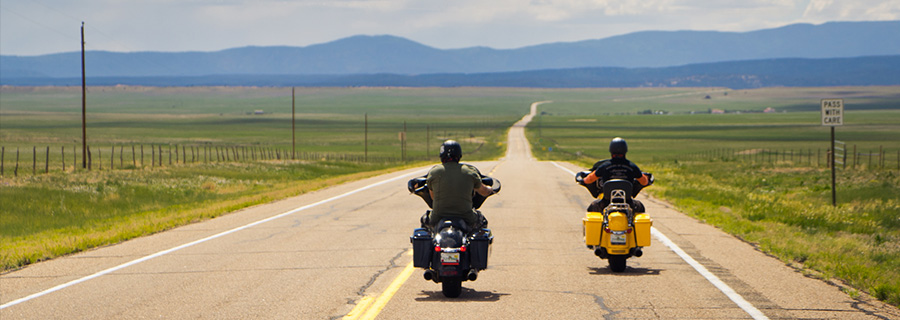
Know your limits and don’t be a tough guy. If you haven’t done any long-haul rides before, don’t plan on pushing 500 or more miles per day. Give yourself adequate time to complete your trip without attempting dangerous days of extreme miles. It’s no fun and can be costly.
Every rider finds his or her level—whether that’s 150 miles per day or 400—after which point riding becomes work. Like fuel, leave a little energy in reserve when planning your day’s ride. There may be times you’ll need to push out a few more miles to get to the next bed.

On our guided tours, we keep most days between 200 and 260 miles. With plenty of rest breaks, this allows everyone to get enough rest at the end of the day and start early the following morning.
Think about avoiding night riding, when less visibility and fatigue are more of a factor, and because deer have become the most dangerous animal in the world. Wildlife gets more active at dawn and you’d want to have no encounters with large animals on any of your motorcycle trips.
27. Take a 20-minute break for every 1.5 hours of riding, know your limit
Veteran distance riders suggest getting into a rhythm. For example, some stop for rest and refreshment every tank of gas, depending on mpg and fuel capacity. Some studies have shown you will actually get their faster (and safer) with regular break intervals. Eat light, stay hydrated, and it should go without saying don’t drink alcohol. We recommend stopping for a break every 60-90 minutes. Pace yourself on longer multi-day rides. How you feel today will affect how you ride tomorrow. A fatigued rider is not as alert and doesn’t react as fast as a rested rider.
28. Take a day off for every 7 days of riding
On EagleRider’s 16-day guided tours, we always buffer a day for rest. On Route 66 tours, it’s in Santa Fe where you can spend the day bargaining with local jewelry shops, horseback riding, or enjoying the day at the hotel spa. On Wild West tours, we take a break in Las Vegas, which leaves plenty of room for ideas on local things to do, from Cirque du Soleil to Bellagio Fountains, Freemont Street experience, and much more.
Set yourself up for success by buffering a longer rest stop or a day off. Of course, all of us love spending time on the bike, but local attractions can be just as fun to explore.

29. Keep your eye on how much fuel you have left, find a mobile app for this
It’s a big country, with occasional long, empty gaps between anything resembling a town or the sweet oases of gasoline and coffee we have grown to take for granted. Don’t run it dry, obviously, but start looking for gas stations some 20 or 25 miles before you’re running on fumes.
No one wants to see the dreaded signpost up ahead that reads, “No Services Next 100 Miles.” You need to be prepared for stretches like this, which may involve packing non-perishable foods, water, and bungeeing a full gas can to your bike. Better to have it and not need it, then need it and not have it.
Find an app that can track your mileage on each full gas tank and can alert you ahead of time if you’re running low with no gas stations ahead.
30. Don’t lose your keys, always lock your bike
We saved the best for last! The two of the most unpleasant scenarios on the road are lost keys and lost motorcycle. Nobody wants to be in either situation and both are preventable if you follow a few simple guidelines:
- Keep your bike keys/fob on a lanyard, either hanging on your chest or attached to your pocket
- Have a quality disk lock (we provide one with all our bikes)
- Make sure to lock your bike with both steering/fork and disk locks
- Consider adding an alarm system to your bike
- Build good habits by placing bike keys in the same spot each time you ride or stop for overnight stays
Harley-Davidson touring models have key fobs that you don’t need to insert into the ignition. If it’s your first time on a Harley, keep an eye on the fob. There is a fee for lost keys for our motorcycles.
WHAT’S NEXT?
Now that you have all this information in front of you, picking the riding destination or route is the next step. Here are a few helpful resources to get you started:
Map of EagleRider locations – With over 200 rental locations, it’s easier than ever to conveniently ride out of major cities and nearest hubs to amazing motorcycle roads. Get familiar with our locations and that’ll get your mind thinking about places you’ve always wanted to ride to.
EagleRider routes and tour itineraries – we have 100+ itineraries on our website for both guided and self-drive tours. Browse them to find the destinations you want to visit. We share daily stops for each tour. This can be a great starting point from which you can build on your custom trip if you wish. Or simply book a tour and follow the exact route we suggest.
Rally schedule – planning longer trips around rallies (Sturgis, Daytona Bike Week, Laconia, etc.) is a great way extend your rides and add interesting routes. Many riders love riding into Sturgis from all corners of the country. If you have the time, find a rental location where you want to start and build your route to the rally. We offer one-way rentals, so you can easily drop off the bikes in another city and simply fly home.
Local rides for top travel destinations (Los Angeles, Las Vegas, San Francisco, etc.) - (Los Angeles, Las Vegas, San Francisco, etc.) - if all you have is a day or two, we made a list of local rides near our locations.

We hope you found this guide helpful. A lot was covered here and surely you may need to come back and reference some tips and suggestions as you continue to plan your trips.
- Harley-Davidson
- Royal Enfield
- Adventure & Dual-Sport
- Sport Touring
- Retro/Vintage
- Trikes, Sidecars & Scooters
- Buyers Guides
- New & Cool
- Electronics
- Parts & Accessories
- Books, DVDs & Other
- Latest News
- Tips & Tricks
- Rallies & Clubs
- Learning To Ride
- Other Features
- Favorite Rides
- Midwest U.S.
- Northeast U.S.
- International
- Favorite Rides & Destinations Digital Edition
- Rider Magazine
- Rider Enewsletter
- American Rider
- Woman Rider
- Powersports Business
- Market Research
- Consumer Panel
- Subscriber Login
- Customer Service

Chasing My Heritage on a Cross-Country Motorcycle Trip
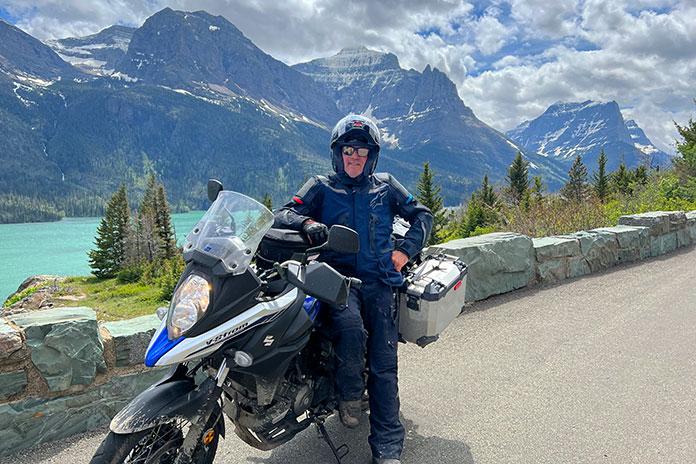
As motorcyclists, we feel drawn to the open road. As Americans, we want to take in as much of what our country has to offer as we can. And as human beings – especially if we’re of a certain age – we want to see our family and friends face-to-face, to hug them and shake their hands and hear and tell stories new and old. Phone calls and texts help us stay in touch, but they are a poor substitute for the real deal. I decided to check all the boxes with a cross-country motorcycle trip.
I live in Southern California, and I have family and friends all over this great nation, from sea to shining sea. I’ve ridden cross-country many times before, but I was overdue for a special lap around America, one where I could see the sights and visit the important people in my life without a strict agenda or schedule. When I opened a Dove chocolate and saw the advice “Live every day with no regrets, it’ll be worth it” inside the wrapper, it felt like a calling. I packed my gear and headed east.
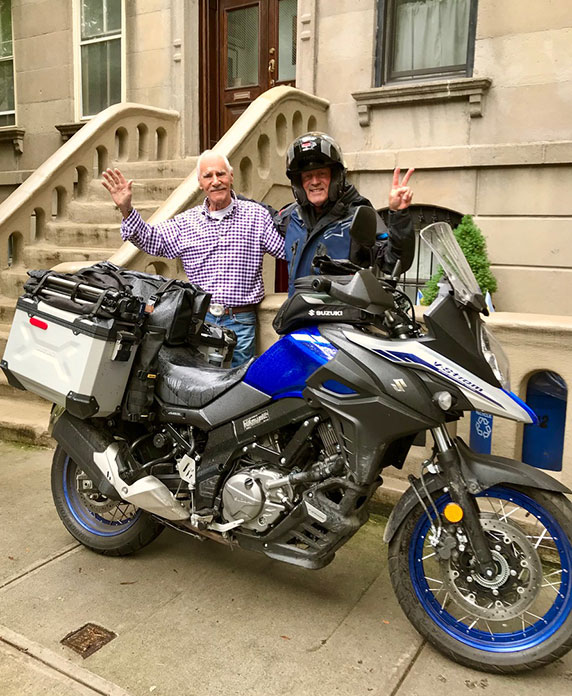
Family Roots
Back in 1940, my grandparents loaded up their ’37 Packard with all their belongings, including my 10-year-old father, Mark, and his 7-year-old younger brother, Bernard (where I got my middle name) and headed west. Leaving Youngstown, Ohio, they made their way to Route 66 and followed it to Burbank, California, where Grandpa Seth got a welding and fabricating job for Lockheed Aircraft.
Before long, my grandparents purchased a Texaco station that became the family business. Our family still owns the building, which now houses an auto body shop. My grandparents died just before I was born, but I believe I inherited my love and innate abilities for fabricating and restoring motorcycles from my Grandpa Seth. I still use his old Wilton bench vise, hand tools, and other equipment.

Time was of the essence with my own cross-country journey, some 82 years later. My dad was approaching his 95th birthday, and ol’ Uncle “Bud” (Bernard’s nickname) was pushing 92. They don’t travel anymore, and they hadn’t seen each other in over a decade. I decided to keep the trip a secret from Dad. My plan was to ride to New York and do a surprise video call between the aging brothers.
I left my house in Thousand Oaks, California, on Memorial Day and returned home in time to celebrate the 4th of July. Over a month and more than 10,000 miles, I passed through 33 states, visited and stayed with dozens of people who were already near and dear to my heart, and enjoyed meeting many new friends as well.
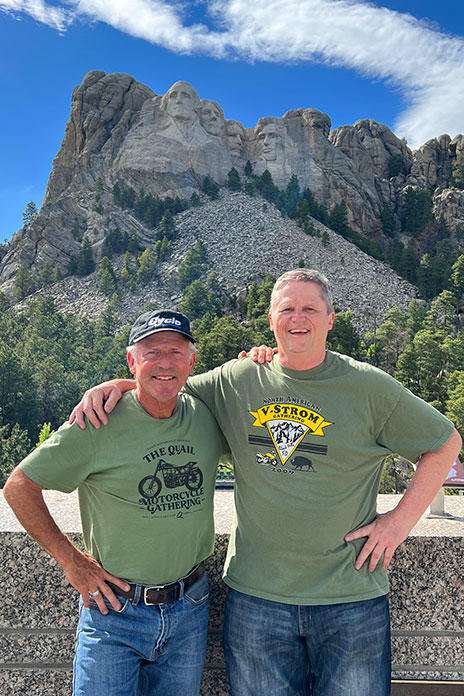
To get ready for my journey, Alpinestars and Shoei/Helmet House provided me with gear, Nelson-Rigg set me up with a waterproof duffel, and my friends at Suzuki were kind enough to loan me a 2022 V-Strom 650XT with an accessory tankbag and panniers. The V-Strom 650 is one of the best bang-for-the-buck adventure bikes out there. It fits me like a glove, has a really comfortable seat, likes to go off-road here and there, and only asked for gas in the tank and PJ1 on the chain every now and again.
Related: 2018 Suzuki V-Strom 650XT vs V-Strom 1000XT | Comparison Review
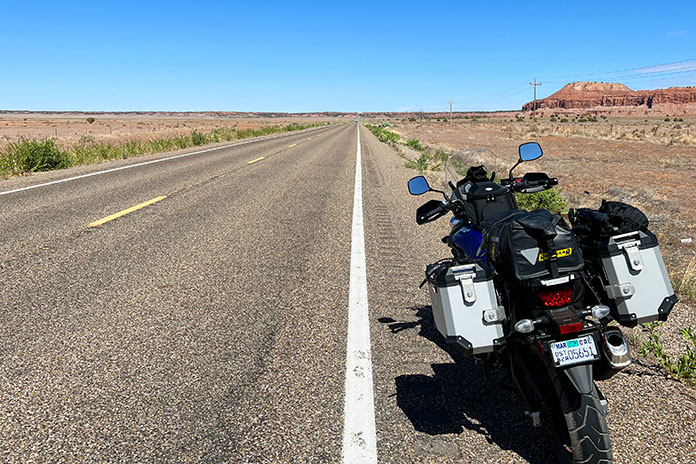
With the bike packed, I said my goodbyes and my prayers, pulled in the clutch, dropped into 1st gear, and rolled away from home. It was a surreal feeling starting a ride of this magnitude, wondering what might be in store for me.
A Cross-Country Motorcycle Trip: Eastbound and Down
Before departing on this ride, I traced a big outline of the U.S. and each of the lower 48 states on a large sheet of heavy-duty paper, and at the top I wrote “2022 Friends & Family Ride!” I kept it rolled up in a cardboard tube and used it to document my route. Along the way, I had family, friends, and other folks write notes and messages on the map.
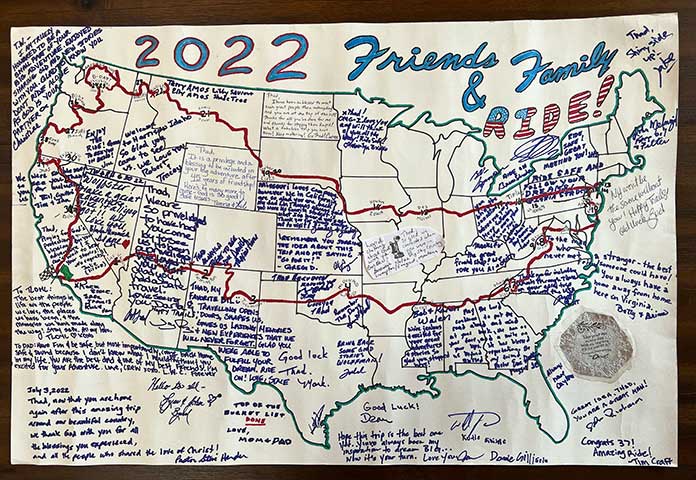
After riding across the Mojave Desert to Las Vegas, I continued northeast and rode through Zion National Park in Utah. I meandered east to Four Corners, got off my bike, and managed to be in all four states at once with my feet in Arizona and New Mexico and my hands in Utah and Colorado. In New Mexico, I visited friends in Farmington and Tucumcari. As the trip unfolded, I found that most of the time there was another friend or family member with whom I could stay within a day’s ride.
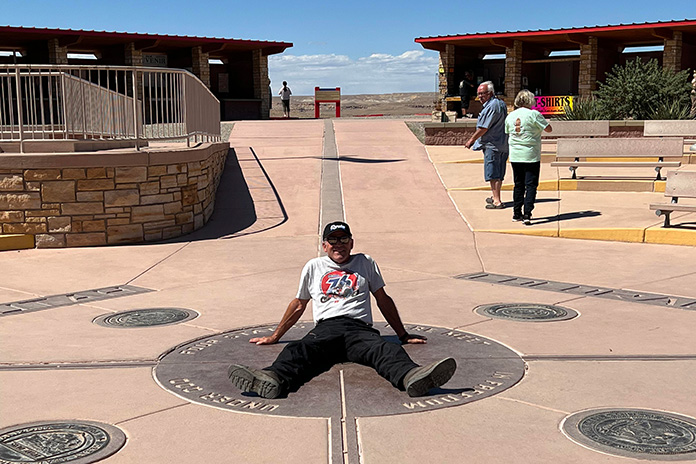
I blazed across the Texas Panhandle on my way to “McDonald Land,” the nickname for where Norm and Lucy McDonald live near Tulsa, Oklahoma. Norm is the “N” in K&N filters, which nearly everyone has run in their bikes or cars at some point. I used to pitstop there in the early ’80s when traveling around the country during my AMA roadracing days. I met the McDonalds through their son, Sam, when we were both novices in 1980. Through K&N Yamaha, Norm and Lucy sponsored countless racers over the years, with Malcolm Smith being one of the most notable. They are wonderful people whose friendship is precious to me. Staying with them again like in the good ol’ days was very special.
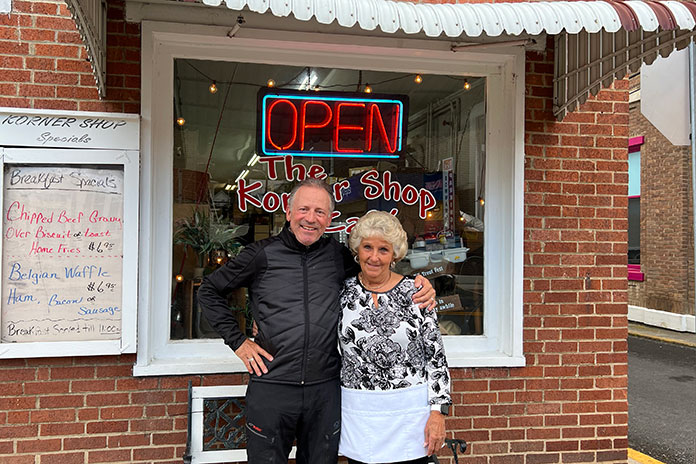
After visiting other friends in Memphis, Tennessee, I skipped across the tops of Mississippi, Alabama, and Georgia and made my way up into the Appalachians and onto the Blue Ridge Parkway. Rider magazine readers have seen plenty of great ride stories from this area, and now I got to do the riding!
See all of Rider ‘s touring stories here.
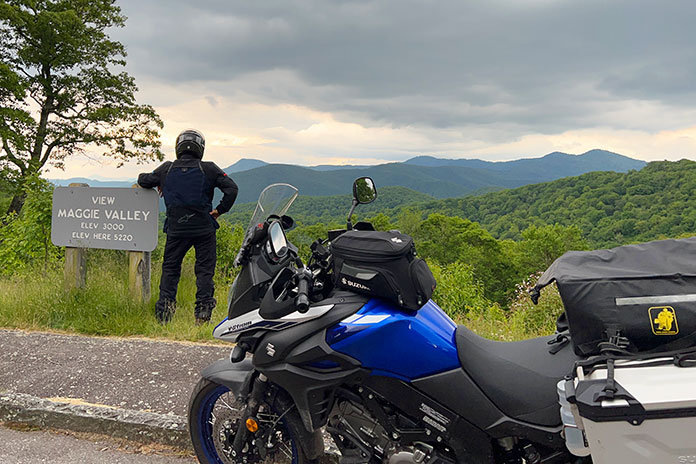
The weather was perfect, the scenery was beautiful, and I took some side trips on the 650XT down small roads and trails. In Maggie Valley, North Carolina, I stopped at the Wheels Through Time Museum . I love old bikes and old American stuff, so this place is like heaven to me. Dale Walksler has passed, but his son Matt has taken over and is doing an awesome job keeping the museum going.
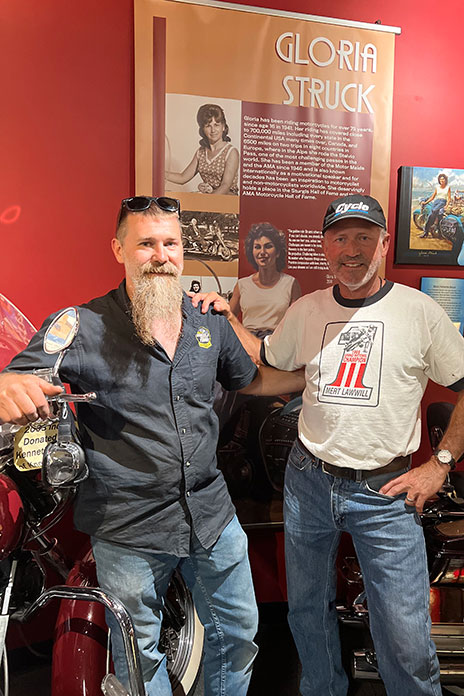
Heading North
I rode up Skyline Drive and into Virginia, where I spent a couple nights at Brian and Betty Richardson’s 19th-century sheep farm. Rider’s former editor-in-chief, Mark Tuttle, connected me with the Richardsons back in 2009, and I raced Brian’s homebuilt Moto-Electra electric bike in the TTXGP series for a few years. In 2013, we set the coast-to-coast world record for electric vehicles on the same bike by crossing the U.S. in 84.5 hours. Brian and I became good friends, and for years I’ve been telling him I would ride up to his farm one day. I finally did, and we spent a day riding together on awesome backroads.

I left the farm in the morning and was soon greeted by a dramatic change in scenery. By midday, I was taking a selfie in front of the Capitol in D.C. I wished I could help straighten things out there, but I decided I’d rather ride my motorcycle. I hightailed it out of D.C. and crossed the Delaware Bay on a ferry from Lewes, Delaware, to Cape May, New Jersey, which is the oldest resort town in America and a neat place to stay.
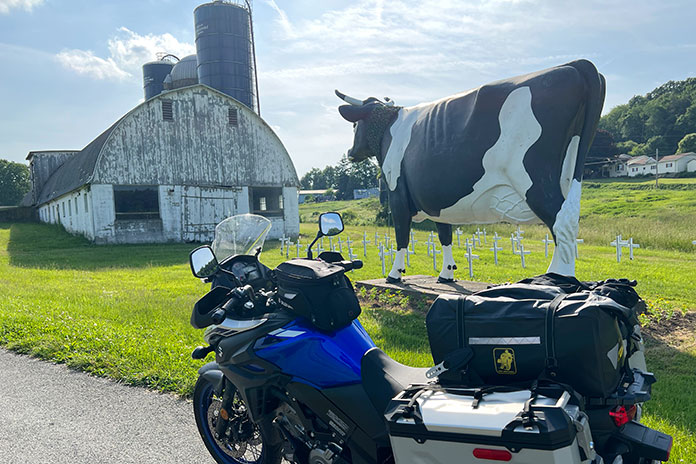
Another special thing about New Jersey is one of its residents: Gloria Struck, the first lady of motorcycling, who is 97 years young. I wrote a story for Rider (March 2013 issue) about Gloria and the Motor Maids, and we have been close friends for a long time. We first met years ago at Daytona Bike Week, where I noticed her Harley had Clorox bottles cut in half and strapped to the handlebar as wind deflectors. I had done that before myself, but when I found out it was Gloria’s bike and that she had ridden from New Jersey, where she had to shovel snow to get out of her driveway, I immediately developed a deep fondness and respect for this woman.
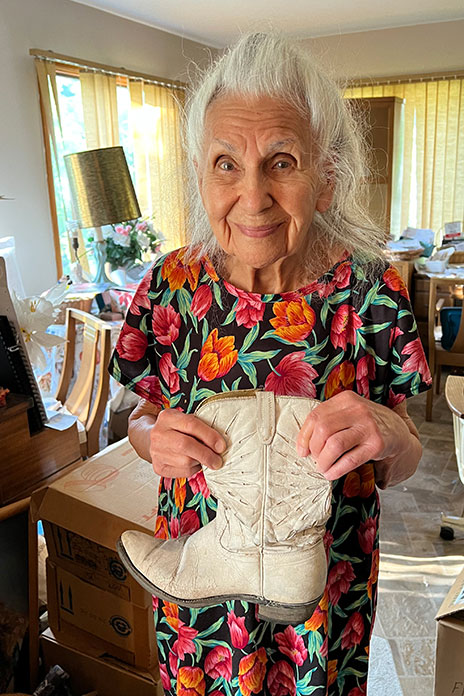
Spending a couple nights with Gloria, reminiscing and listening to her talk about riding her motorcycle, or the trike she’s going to get when she turns 100, was absolutely priceless. I highly recommend buying her book, Gloria – A Lifetime Motorcyclist: 75 Years on Two Wheels and Still Riding , which was published in 2018.
Gloria did her first solo ride to Daytona in 1951 to watch the beach races. Dick Klamfoth won that year (and also in 1949 and 1952), and as fate would have it, Dick and I became friends, and I helped him build the Daytona 200 monument, which took several years. He and his wife, Bev, are gone now, but later in my ride, I would carry on our memories by visiting their daughter, Christy, in Ohio.
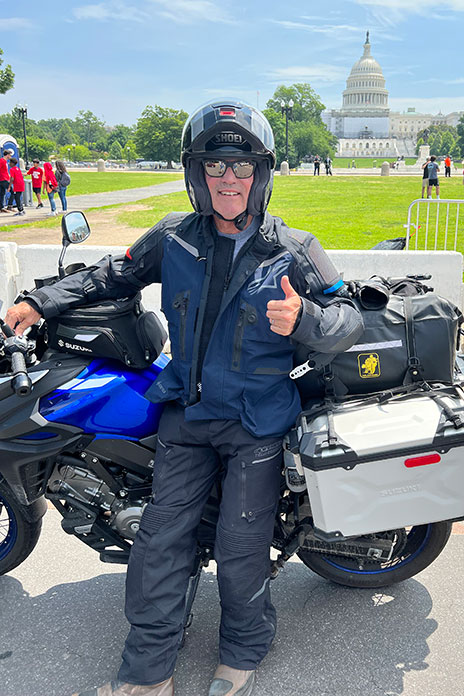
The Big Apple
From Clifton, New Jersey, I passed under the Hudson River through the Lincoln Tunnel and popped out in midtown Manhattan. Riding around the Big Apple in the rain was quite an adventure. After taking the Queensboro Bridge over the East River to Long Island City, I finally arrived at the easternmost point of my journey and visited Uncle Bud. It had been hard to keep the secret, but when we surprised my dad with a FaceTime call from his brother and son, it was a very special family moment.
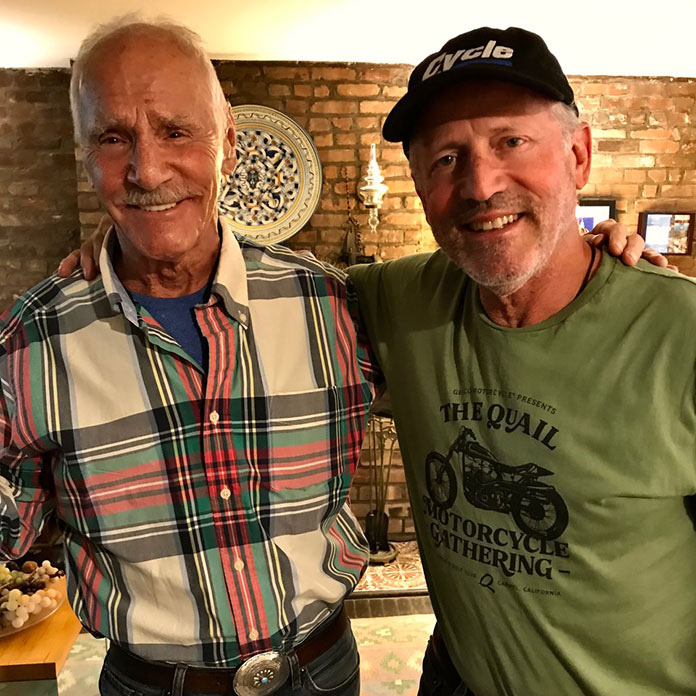
Saying goodbye to good ol’ Uncle Bud and wondering if it would be the last time we’d see each other face-to-face was emotional, but I laughed as always when he said, “See ya later, alligator!”
Crossing Manhattan again, I was officially on my way home. It felt good to make it out of the big city and know the rest of the ride would be mostly rural countrysides and small towns.
Westward Ho!
In our family’s hometown of Youngstown, Ohio, I stayed with my cousin John. We had never met and had fun getting to know one another. Using Bud’s recently sketched picture of the family home, we found the now-abandoned dwelling where they once lived. It was like searching for hidden treasure with a map Bud drew from his memory of a place he left at the age of 7! John showed me around, and I imagined my family living there in the old steel town’s heyday. I thought about them in the old Packard driving away from the house on Worthington Street for the last time, looking back at what was being left behind and then looking forward, wondering what life would be like in California.
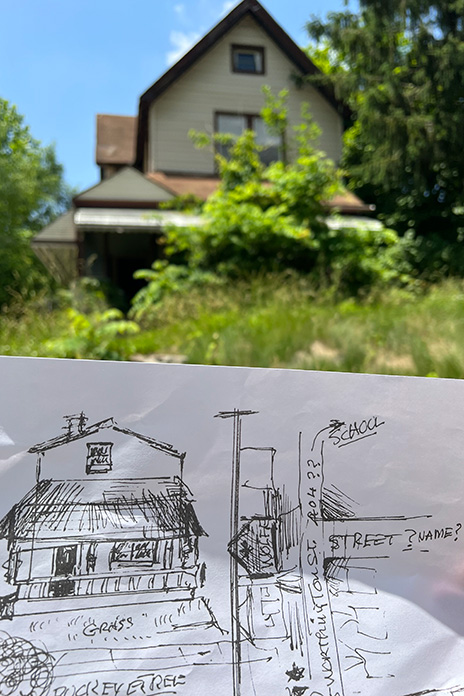
From Youngstown, I rode southwest to Columbus, where I visited the AMA Hall of Fame Museum and then popped in on Bruce Linsday. Bruce is a top guy in the antique motorcycle world with an unbelievable collection of early American motorcycles. Years ago, when we were in Death Valley riding our old Harleys, he invited me to stop by his place so I could ride a particular old Harley dating back to 1905. The factory in Milwaukee has one in its museum, and Bruce has the other one. These two bikes are the oldest Harleys in existence. The factory’s bike is under glass and will never be ridden, so I was fortunate enough to be able to ride the oldest running Harley there is! Quite an experience.
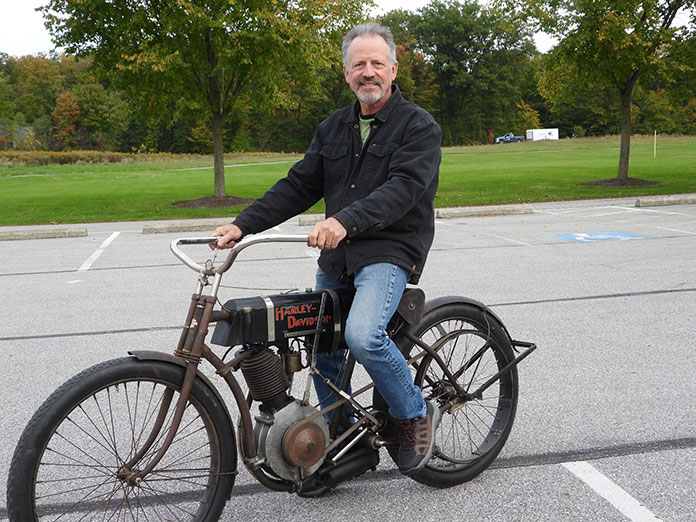
After a stop in Des Moines, Iowa, I continued west to South Dakota. In 2009, I attended the V-Strom Rally in Rapid City on assignment for Rider (April 2010 issue) and made friends with resident V-Strom rider Carter Kirk. He let me borrow his bike for the rally, and I had a wonderful time exploring the Black Hills. Since I was traveling on a new V-Strom 650XT on my family-and-friends tour, I had to visit Carter.
With him on his old V-Strom and me on my new one, we spent a day riding and sightseeing. We stood at the base of Mount Rushmore and took in the majesty of one of this country’s most patriotic treasures. After dinner in Sturgis, we capped off an awesome day with a night ride home through pouring rain and an unbelievable lightning show. When we made it home, I had a good laugh when Carter asked me if I was worried during the ride. I tried to act like I wasn’t.
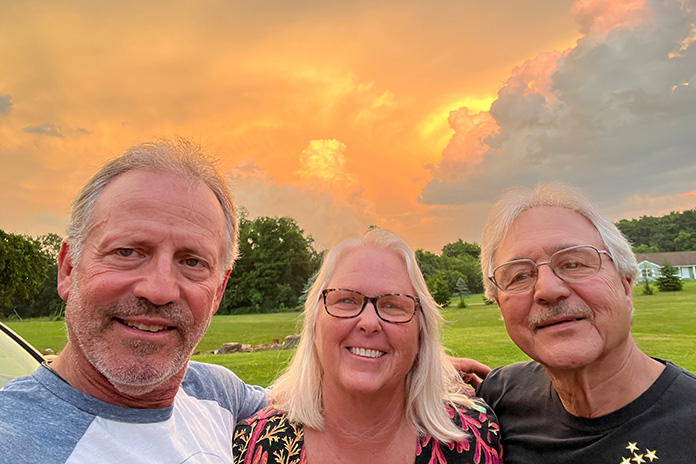
See all of Rider ‘s Suzuki coverage here.
After visiting Devils Tower in Wyoming, I continued northwest into Montana. I love this part of the country, and after riding through some more open grassland, I was finally rewarded with a view of the snowcapped Rocky Mountains. I rode the incomparable Going-to-the-Sun Road in Glacier National Park, then made my way into Idaho, where I visited my nephew, Robert, and his wife, Tracy, in the little community of Harrison. They recently moved there from our hometown in Southern California to a little house overlooking a lake.
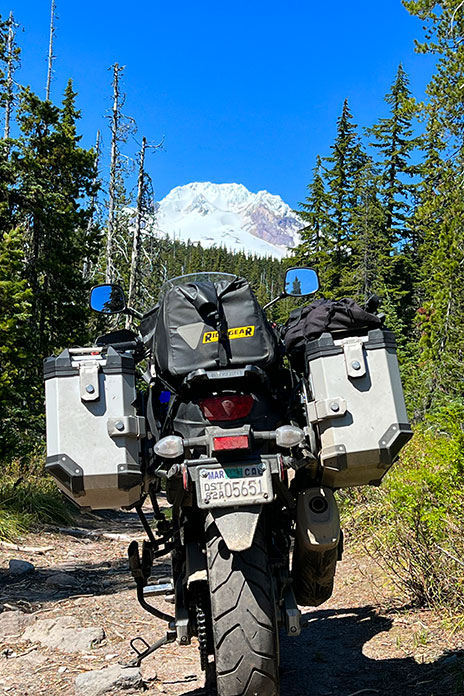
Farther west, I enjoyed riding the Cascade loop in Washington with all the forest roads and the surprising views of white-topped volcanic mountains that appear out of nowhere. After a stop to visit my sister-in-law Jill in Bend, Oregon, I finally saw what I was waiting for: the beautiful blue Pacific Ocean. I punched my fist into the air and hollered “Yahoo!” inside my helmet. I love riding along the western edge of our country.
The Homestretch of My Cross-Country Motorcycle Trip
Back in California, my next stop was Eureka, a nice little coastal town where I stayed with my Uncle Jim and Aunt Jan and visited my cousin Bill. At this point in the trip, I had seen all my living relatives and felt I had accomplished what I set out to do.
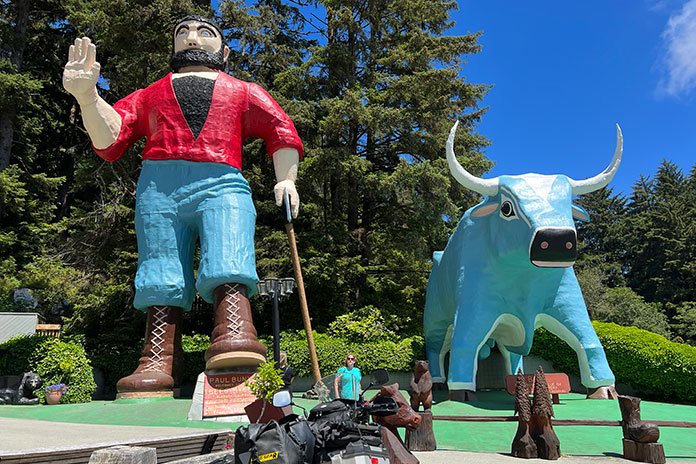
But there were more miles to cover, such as riding among the majestic coastal redwoods before heading inland to visit Lassen Volcanic National Park in northeastern California. Zigzagging my way through the gold country of the Sierra Nevada, around Lake Tahoe, and past Mammoth Mountain. And then finally crossing the Mojave Desert again to get home.
What a feeling to turn the corner and know this journey had come to an end. There in the driveway was my wife, Jody, and my daughter, Kelly, waiting for me with open arms. I hadn’t even gotten off the bike before the tear-filled hugs began. Wow, what a feeling!
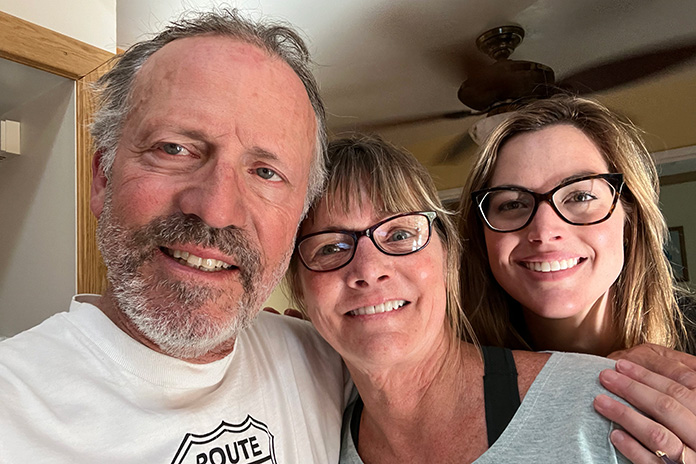
I arrived home in time for my dad’s 95th birthday, and he ended up passing away peacefully two short weeks later. The timing for this trip was perfect, and I’m glad I was able to make it happen rather than make excuses. In the end, our faith, family, friends, and the memories we’ve made (many with handlebars in hand) are all we have. Nothing else matters.
Don’t wait. Just go.
RELATED ARTICLES MORE FROM AUTHOR
2024 husqvarna svartpilen 801 preview, 2024 kawasaki z500 review | video, 2025 indian scout review | first ride.
A very special article about a very special idea. Loved it!
I don’t look as good as Uncle Bud and I’m 30 year younger! Great article
In the end, our faith, family, friends, and the memories we’ve made (many with handlebars in hand) are all we have. Nothing else matters. Don’t wait. Just go.
This one sentence is the essence of what I felt when my Mum recently passed and I began to realize that she left with so much not realized dreams, always devoted everything she had to give for the family without ever being selfish once.
Thanks for sharing your very personal journey.
Good article
Wonderful trip. Thanks for sharing!
Excellent trip. The Vstrom 650 is probably the best bike I ever owned. I’ve ridden across the country twice and did an iron butt with it. Great story.
Beautiful story with a beautiful sentiment.
I loved reading the account of your cross-country trip to connect with family. What an amazing adventure!
LEAVE A REPLY Cancel reply
Save my name, email, and website in this browser for the next time I comment.
CURRENT ISSUE
News & reviews, colorado legalizes lane filtering, 2024 adventure bikes with kevin duke (part 2) | ep. 69..., bmw motorrad days americas returns to barber vintage festival, oct. 11-13,....

- 7760 France Avenue South, Suite 810 Bloomington, MN 55435
- Phone: (763) 383-4400
- Subscribe to Rider Magazine
- Subscribe to Rider eNewsletter
- Contact Rider
- Advertise With Us
- Privacy Policy
© 2024 - Rider Magazine. All rights reserved.

IMAGES
VIDEO